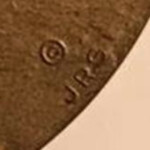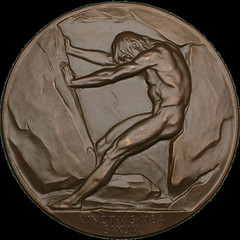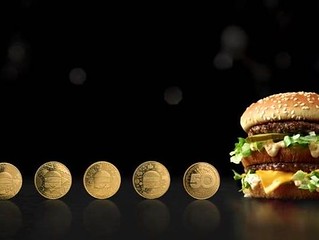
About UsThe Numismatic Bibliomania Society is a non-profit association devoted to the study and enjoyment of numismatic literature. For more information please see our web site at coinbooks.org SubscriptionsThose wishing to become new E-Sylum subscribers (or wishing to Unsubscribe) can go to the following web page link MembershipThere is a membership application available on the web site Membership Application To join, print the application and return it with your check to the address printed on the application. Print/Digital membership is $40 to addresses in the U.S., and $60 elsewhere. A digital-only membership is available for $25. For those without web access, write to: Terry White, Treasurer AsylumFor Asylum mailing address changes and other membership questions, contact Terry at this email address: terrywhite5475@yahoo.com SubmissionsTo submit items for publication in The E-Sylum, write to the Editor at this address: whomren@gmail.com BUY THE BOOK BEFORE THE COINSale Calendar
|
- WAYNE'S WORDS: THE E-SYLUM AUGUST 8, 2018
- NBS EVENTS AT THE 2018 ANA WORLD'S FAIR OF MONEY
- SHIPPING: U.S. PROOF GOLD COINS VOL IV: GOLD
- NEW BOOK: 2018 CANADIAN TIRE NUMISMATIC CATALOGUE
- BOOK REVIEW: THE COINAGE OF AKRAGAS
- BOOK REVIEW: THE COPPER COINS OF VERMONT
- BOOK REVIEW: MEXICAN PAPER MONEY 2017 EDITION
- MICHAEL METRAS (1943-2018)
- INVENTORY COPY OF EARLY PAPER MONEY OF AMERICA
- EARLIER USES OF CIRCULATION/CIRCULATED CAMEO
- 1945 ROOSEVELT PRESIDENTIAL SERIES MEDAL DESIGNER
- MINTMARKS SHOWN ON THE MINT BICENTENNIAL MEDAL
- READER THOUGHTS ABOUT BREEN AND COIN WORLD
- ENGRAVER JAMES SMITHERS
- NOTES FROM E-SYLUM READERS: AUGUST 5, 2018
- BOOK CUTTING ANSWER: VETUSTA MONUMENTA
- MORE ON NUMIS-MAILRS
- QUERY: ANACS GRADER IDENTIFICATION SOUGHT
- 2018 ANA WORLD'S FAIR OF MONEY EVENTS
- J.N.T. LEVICK INDUCTED TO ANA HALL OF FAME
- VOCABULARY TERMS: CAMEO
- DR. GEORGE PETER FRENCH, MD (1865-1932)
- NEW DEALER PROFILE: JEREMY BOSTWICK
- CIVIL WAR MUSEUM SEEKS HODGES BANK NOTE DETECTOR
- BEAUREGARD STATUE TIME CAPSULE OPENED
- AUDIO: COINWEEK INTERVIEWS HEIDI WASTWEET
- LOCAL PAPER INTERVIEWS JEANNE STEVENS-SOLLMAN
- 1792 WASHINGTON PRESIDENT GOLD EAGLE PROVENANCE
- ITALIAN COIN EXHIBIT AT FALL 2018 LONG BEACH
- COUNTERFEIT COIN EXHIBIT AT 2018 ANA WFOM
- A COIN UNITES VICTORIA & ABDUL
- NUMISMATIC NUGGETS: AUGUST 5, 2018
- MEDAL SELECTIONS FROM NUMISMAGRAM: GERMANY
- ESTE NUMISMATIC COLLECTION UPDATE
- ECONOMISTS VS. ETHNOLOGISTS ON THE ORIGIN OF MONEY
- STUDY EXAMINES MEXICO'S COIN PRODUCTION COSTS
- LUCKY EISENHOWER DOLLAR LOST AT AIRPORT
- SOUTH CAROLINA PALMETTO REGIMENT GOLD MEDAL
- MARIA DICKIN AND THE DICKIN MEDAL
- MCDONALD's ISSUES 50TH ANNIVERSARY BIG MAC COINS
- INTERVIEW: MARK SALZBERG OF NGC
- CRANE PAPER'S U.S. CURRENCY CONTRACT
- THE HISTORY OF ‘IN GOD WE TRUST’
- APP BRINGS NELSON MANDELA BANKNOTES TO LIFE
- MEN SENTENCED FOR STEALING SANTA MARGARITA BAR
- IN OTHER NEWS: AUGUST 5, 2018
- FEATURED WEB SITE: FICTIONAL CURRENCY
Click here to access the complete archive
To comment or submit articles, reply to whomren@gmail.com
Content presented in The E-Sylum is not necessarily researched or independently fact-checked, and views expressed do not necessarily represent those of the Numismatic Bibliomania Society.
WAYNE'S WORDS: THE E-SYLUM AUGUST 8, 2018
 This week we open with a reminder of NBS
events at the 2018 ANA World's Fair of Money, two new books, three reviews, an obituary and an update from the Newman Numismatic Portal.
This week we open with a reminder of NBS
events at the 2018 ANA World's Fair of Money, two new books, three reviews, an obituary and an update from the Newman Numismatic Portal.
Other topics this week include the term "circulated cameo", U.S. Mint engraver John Sinnock, early American engraver James Smithers, J.N.T. Levick, Dr. George P. French, sculptors Heidi Wastweet and Jeanne Stevens-Sollman, and Crane paper company.
To learn more about Canadian Tire money, the coins of Vermont, Mexican paper money, egging coins, trail dies, the Nitroglycerin Corporation medal, Hodges’ New Bank Note Delineator, counterfeits, Victoria & Abdul, swinging medallic art conferences, paper money and women's underwear, read on. Have a great week, everyone!
Wayne Homren
Editor, The E-Sylum
NBS EVENTS AT THE 2018 ANA WORLD'S FAIR OF MONEY
Here's a reminder of Numismatic Bibliomania Society events at the upcoming American Numismatic Association convention. I plan to be at all o them, and hope to see a number of NBS members and E-Sylum readers there as well. -Editor
Please visit us at Table 1414 on the bourse near the Kolbe & Fanning and Charles Davis Numismatic Literature tables.
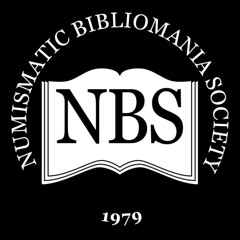 THURSDAY, AUGUST 16
THURSDAY, AUGUST 16
11:30 to 1:00 NBS Board Meeting (open to members), Room 120C
1:00 to 2:30 NBS Symposium, Room 120C Speaker: Roger Burdette on research at the National Archives.
FRIDAY, AUGUST 17
11:30 to 1:30 NBS General Meeting and Fundraising Auction, Room 117
Speaker: David Fanning on current state of numismatic literature market. The Asylum Award winners will be announced.
All events take place in the Philadelphia Convention Center.
Send your photos (JPGs with captions) of NBS members and events from the ANA to nbsasylum@gmail.com by September 1 to be included in
The Asylum Fall issue.
Dan Hamelberg adds:
I am going to bring my M.A. Brown sale and plates to the ANA for NBS display. This was an SH & H Chapman sale on April 16-17, 1897 and was originally intended to be a large format plated catalog with four photographic plates of large cents. At the time, the Treasury Department was somewhat concerned about any U.S. coins or currencies being reproduced by a photographic process. Treasury agents gained information about the pending Chapman M.A. Brown Sale with photographic plates (could it be that some competitor was upset?) and they seized the original glass negatives and destroyed them before the catalogue could be completed.
However, two sets of proof prints were produced before the glass negatives were taken. One of the sets was cut horizontally through the center so it could fit into the smaller size catalogue. The other set survived intact in its original full-size format. I can bring both sets of plates along with the firm's bid book containing prices and names. I also have a second copy with prices and names along with interesting notations.
The Chapmans produced 46 total regular plated catalogs. The M.A. Brown sale plates are unique. Without U. S. Treasury glass negatives confiscation, the number of Chapman plated sales would have increased by one. Perhaps more plated catalogs might have been produced as well without the expectation of possible seizures of photographic plate negatives. In any event, the Chapman plated catalogs are considered a high point of late 19th and early 20th century plated coin auction catalogs produced in the United States, and a high point of any numismatic literature collection.
Thanks, Dan. We'll look forward to this! Fascinating numismatic history. -Editor
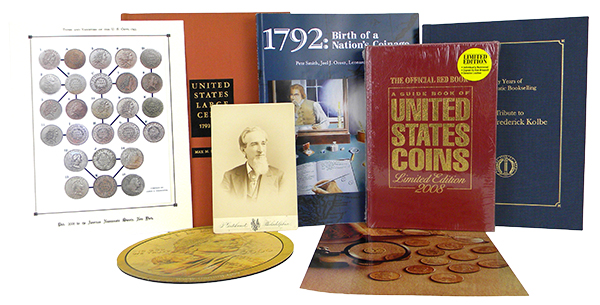
Each year at the ANA World's Fair of Money, the Numismatic Bibliomania Society conducts a benefit auction to raise funds for the organization. All items sold are donated to the NBS by members and 100% of the proceeds go to the NBS treasury.
This year, we are trying to increase participation in the auction by distributing a catalogue of the sale to all NBS members so that members unable to attend in person can participate. You can download a PDF of the catalogue here .
Absentee bids should be sent to David Fanning at df@numislit.com by the end of Thursday, August 16. The sale will take place on Friday, August 17 as part of the NBS General Meeting, to be held in Room 117 of the Philadelphia Convention Center from 11:30 a.m. to 1:30 p.m. Please read the terms of sale before bidding.
Thank you for your support of the NBS!
As noted last time, there are some great lots in the sale at multiple pricepoints - something for everyone. If you can't attend the sale, please do review the catalog and enter some bids. -Editor
To download the catalogue, see:
https://gallery.mailchimp.com/5c68a72f4948c463818f613c2/files/9d01bd03-e538-433c-a4a0-9032ab8942a9/NBS_Auction_2018.pdf
SHIPPING: U.S. PROOF GOLD COINS VOL IV: GOLD
Copies of John Dannreuther's new book on United States proof coins will be shipping soon, but if you move fast you can still get the pre-publication discount announced earlier. -Editor
JD writes:
My container from China arrived Thursday and will be delivered to my storage facility on Tuesday. The pre-pub price of $195 will be good until Wednesday August 8, 2018, when the price will become $250.
I confirmed that checks postmarked through August 7, 2018 will qualify for the prepublication price. Purchases can also be made online at the web site. Here's the earlier announcement with more information on the book and how to order. -Editor
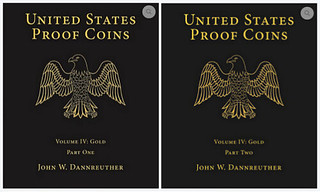 Before this work the only
full-length treatise on United States Proof coins was Walter Breen's 1977 encyclopedia that later was revised in 1989. Although that seminal book moved the scholarship light years
forward, its main drawback was its lack of illustrations. It was published before the digital age and was written on typewriter and laid out in the way books were done for
generations. Thirty-five-millimeter photographs were cut and pasted into a layout and that layout was converted to a transparency called a “blue.” From the blues, a printed book
was produced.
Before this work the only
full-length treatise on United States Proof coins was Walter Breen's 1977 encyclopedia that later was revised in 1989. Although that seminal book moved the scholarship light years
forward, its main drawback was its lack of illustrations. It was published before the digital age and was written on typewriter and laid out in the way books were done for
generations. Thirty-five-millimeter photographs were cut and pasted into a layout and that layout was converted to a transparency called a “blue.” From the blues, a printed book
was produced.
This volume on Proof gold has nearly 2,000 illustrations and every Proof gold variety either has a full color photograph or a close-up illustration of its pertinent features. This is only possible because of digital photography and software for a work of this magnitude. Details that previously only could be verbally described is now illustrated with such clarity that words are now secondary. Noting the date's position by where an imaginary vertical line aligns with the left base of the 1 digit aligns with a dentil below it is still noted in this work, but many date positions have obvious other differences. Micro photographs of date positions illustrate these differences and allow easy identification of varieties.
After 1840, nearly all United States coins were produced from completely hubbed dies. Thus, the differences in Proof and circulation strike dies after this point often are the position of the hand-punched dates and little else. Reverse dies are even harder to differentiate, as the ones from Philadelphia (the majority of the Proof coins in this book) usually differ only in post-hubbing features. There is no mintmark in a different position for Philadelphia Proofs to distinguish varieties, as they do not have them!
In the past, collectors wanted one example of each date and Proofs were the ultimate collector coins. Today, collectors want both Proof and Mint State examples, so Proofs have lost some of their luster, as many collectors today have concentrated on rare circulation strike issues or common issues in very high grades. Admittedly, some of this focus is deserved, as there are many rare issues and there are numerous common-date coins that are very difficult to find in ultimate states of preservation. However, the collectors of the past appreciated the “Coiner's Caviar” as Proofs were the best coins produced by the United States Mint and those throughout the world. Today, nearly every mint in the world produces Proof coinage – the ultimate examples of their coinage. Mints are proud of their coinage and Proof coins are the ultimate examples of their output. The care in producing and preparing the dies and planchets results in nearly perfect coins. They are miniature works of art!
Hopefully, these four volumes (this work on gold, followed by silver, copper, and nickel treatises) will cause a renaissance in collecting Proofs. In reality, Proof gold coins are among the most sought after and desirable issues in United States numismatics, but the other metals in the ultimate format have languished in recent years. Proof eagles and double eagles are highlights in dealer's cases and auctions, just as one can imagine they were throughout the years past.
These four works will systematically identify every known Proof variety issued by the United States prior to 1916. By doing this, collectors will then be able to assemble variety sets of Proofs just as they do for large cents by Sheldon and Newcomb varieties, half dollars by Overton numbers, and the other circulation series that have been extensively studied and have had their varieties enumerated.
The author hopes that collectors, dealers, and others interested in numismatics will enjoy reading these works as much as the author enjoyed writing them. It is the culmination of a life-long fascination with the Mint's pinnacle of their output – the best examples of the coiner's work – Proof coins.
To read the earlier E-Sylum article, see:
NEW BOOK: U.S. PROOF GOLD COINS VOL IV: GOLD (http://www.coinbooks.org/v21/esylum_v21n07a02.html)
For more information, or to order, see:
https://www.orcararities.com/
NEW BOOK: 2018 CANADIAN TIRE NUMISMATIC CATALOGUE
The Canadian Tire Coupon Collectors Club has published a new edition of their catalog of Canadian Tire Money and associated coupons. - -Editor
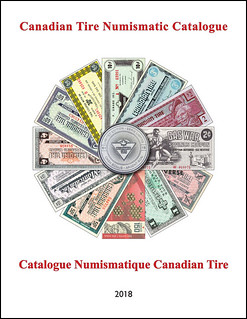 The 2018
Canadian Tire Numismatic Catalogue contains all the regular issues of notes issued by the Corporation, the Petroleum division and Simard-Montcalm. The large majority are made by
Canadian Banknote Company and British American Bank Note.
The 2018
Canadian Tire Numismatic Catalogue contains all the regular issues of notes issued by the Corporation, the Petroleum division and Simard-Montcalm. The large majority are made by
Canadian Banknote Company and British American Bank Note.
All notes issued until the end of July 2018 are included.
There are nearly 1200 images describing the notes. This catalogue is in full color and the format is 8.5” x 11” and has 148 pages.
For more information, or to order, see:
2018 Canadian Tire Numismatic Catalogue – Printed Copy $50.00
(https://ctccollector.ca/store/shop/2018-canadian-tire-numismatic-catalogue-printed-copy/)
2018 Canadian Tire Numismatic Catalogue – Downloadable $12.00
(https://ctccollector.ca/store/shop/2018-canadian-tire-numismatic-catalogue-downloadable-copy/)

BOOK REVIEW: THE COINAGE OF AKRAGAS
In her email Newsletter #79, Shanna Schmidt recommends the new book on coinage of Akragas by Ulla Westermark, and links to a review in Coinsweekly. -Editor
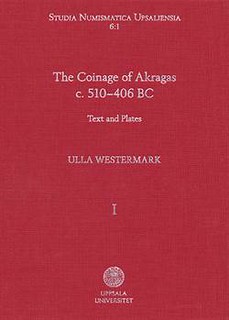
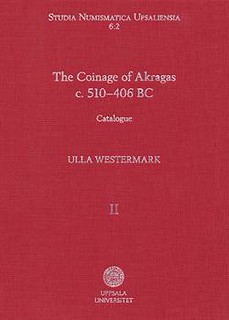
Ulla Westermark book on the Coinage of Akragas
Ulla Westermark, a distinguished academic from Sweden, has published a comprehensive study on the coinage of Akragas. A wonderful article written by Coinsweekly discusses Ms. Westermark's long journey in getting the two-volume set published. It is available for a reasonable amount through Uppsala University in Sweden. Here is a link for purchasing the book and also a link to the article in CoinsWeekly. I encourage you to purchase a copy for your library if you have any interest in the beautiful coinage of Akragas.
http://acta.mamutweb.com/Shop/List/-Studia-numismatica-Upsaliensia-ISSN-1652-7232/66/1
http://www.coinsweekly.com/en/News/Book-on-Akragas-by-Ulla-Westermark-published/4?&id=5528
BOOK REVIEW: THE COPPER COINS OF VERMONT
Chris McDowell, Editor of the Journal of Early American Numismatics (JEAN) published a review of Dave Bowers' new book on The Copper Coins of Vermont on CoinWeek August 1, 2018. Be sure to read the complete article online. -Editor
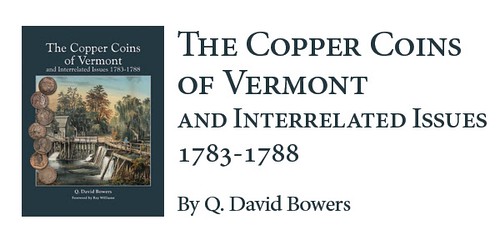
Q. David Bowers’ newest book, The Copper Coins of Vermont and Interrelated Issues 1783-1788 is the culmination of over 60 years of study devoted to numismatics and the Vermont copper series. Since 1952 Bowers’ contributions to the “Hobby of Kings” have gone unabated and with the passing of Eric Newman, Dave now assumes the mantle of Elder Statesman of the hobby and is perhaps the greatest ambassador coin collecting has ever known. Fortunately for us, Dave is far from retiring as his latest book demonstrates he has much left to offer.
To read the complete article, see:
Dave Bowers’ Newest Book on Vermont Coppers Has Something for Everyone
(https://coinweek.com/education/numismatic-books/new-book-by-qdb-on-vermont-coppers-available/)
To read the earlier E-Sylum article, see:
NEW BOOK: THE COPPER COINS OF VERMONT (http://www.coinbooks.org/v21/esylum_v21n25a03.html)
BOOK REVIEW: MEXICAN PAPER MONEY 2017 EDITION
Pablo Hoffman submitted this review of Mexican Paper Money, 2nd edition. Thank you! -Editor
edited by Corey Frampton, Duane Douglas, Alberto Hidalgo & Elmer Powell.
World Numismatics, LLC, PO Box 5270, Carefree, AZ 85377.
Available only as digital download from worldnumismatics.com. Price $35.
IBNS #224 (1960s) /#10676 (2012)
The human species enjoys peace, yet seems to irresistibly pursue conflict. We interminably wage invasion, war, and conquest through subjugation of others. Those others, not unexpectedly, often resist. Such conflict has been a persistent, defining force in Mexico during its 10,000 years of evolution. The wide horizons and profound resonances of Mexican paper money, just as any deep comprehension of the vast panorama of Mexican history, cannot be grasped except against the backdrop of these dramatic and often violent events.
The Aztecs dominated their era, exacting tribute from their subjugated neighbors in material goods, slaves, and sacrificial human offerings to the gods as inked in the ancient codices on amatl (paper made from the bark of the fig tree). The victory of the conquistadores simply brought more of the same, summoning brutal dominance and new gods, substituting the fanatic dogma of Spanish Catholicism and the Spanish Inquisition for the ancient Aztec deities. Three of the last five centuries of Mexico's existence were under the iron hand of Spanish colonial despotism. The indigenous people struggled for their independence against the stranglehold of their Iberian overlords. Whether the slash of obsidian-blade macuahuitl cudgels wielded by Aztec warriors bedecked as eagles and jaguars, or the rumbling of post-Conquest cannons pounding like hoofbeats of the Four Horsemen of the Apocalypse, war, famine, death, and disease were frequent invaders into nearly all the land.
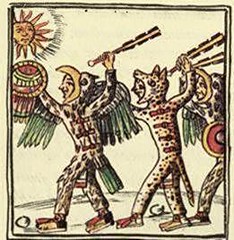 Chaos was the color
of the common man's life. Normal distribution of money from the mints of the colonial masters through intermediary channels such as banks, and on into the hands of the
populace, was disrupted. Even in Mexico City, the very heart of the empire, brigands and highwaymen so frequently robbed the transports carrying coinage that these
transfers were discontinued or became sporadic to many locations. Gresham's Law ensured that much of the scant dole and dribble of prized silver or gold that did reach the
people was hoarded, squirreled away buried in earthen pots or sealed into adobe walls. Time went on, life went on, subjugation and resistance went on. But always,
even amid turmoil, daily needs went on. Hand-to-hand commerce continued. As ever, wages had to be received and spent, services, food, and goods bought, rent and debts
paid. Barter, the ancient mechanism of exchange, was too clumsy to sustain the complex web of everyday transactions.
Chaos was the color
of the common man's life. Normal distribution of money from the mints of the colonial masters through intermediary channels such as banks, and on into the hands of the
populace, was disrupted. Even in Mexico City, the very heart of the empire, brigands and highwaymen so frequently robbed the transports carrying coinage that these
transfers were discontinued or became sporadic to many locations. Gresham's Law ensured that much of the scant dole and dribble of prized silver or gold that did reach the
people was hoarded, squirreled away buried in earthen pots or sealed into adobe walls. Time went on, life went on, subjugation and resistance went on. But always,
even amid turmoil, daily needs went on. Hand-to-hand commerce continued. As ever, wages had to be received and spent, services, food, and goods bought, rent and debts
paid. Barter, the ancient mechanism of exchange, was too clumsy to sustain the complex web of everyday transactions.
Little or none of the traditional Spanish colonial coinage of gold doblones and silver reales was available to the public, so out of dire necessity the people did what they always do: they improvised. Defying vice-regal prohibitions, illegal vest-pocket and back-room mints popped up. Chimneys erupted smoke, crucibles poured out liquid metal, anvils rang under hammer blows. Crude dies to cast or stamp devices and denominations were painstakingly, clandestinely designed. People invented what they needed, and what they needed was money. If it wasn’t as elegantly designed or finely produced as the old Spanish pillar dollars and pieces-of-eight, or the later republican coinage, no matter. Employers and employees, ranchos and ranch-hands, businesses and clients, sellers and buyers, all made do with the motley quasi-currency, and carried on. What they made do with was an unofficial medium of exchange consisting largely of a vast variety of tokens, often in limited local circulation, usually coined in copper or bronze. People had no option but to accept them, calling them pilones, tlacos, fichas, or fichas de hacienda. But a new problem quickly arose: they ran out of copper. Again, they improvised. They manufactured the fichas out of other metals at hand; they melted down and alloyed brass, iron, white metal, lead. When metal disappeared, they used wood, leather, bone, even glass, and then even the unthinkable: paper!
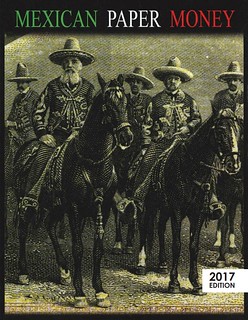 And here is where the curtain rises
on the story of Mexican paper money. The earliest known emission of paper currency in Mexico was issued in 1813, printed on heavy paper, in small
fractional real notes, we are told in Mexican Paper Money. They were from San Miguel el Grande, a municipality in the State of Guanajuato,
then predominantly populated by the Chichimeca people. The town was situated at the epicenter of the uprising against the Spanish. The struggle had already begun three
years before; it consumed more than a decade before the sneering gachupines fled, the shackles were broken, and freedom was won. The town is famously associated
with a major emblematic moment in Mexican history, el Grito de Dolores, the rhetorical ‘first shot’ of the Mexican War of Independence, a call-to-arms
by the charismatic priest Miguel Hidalgo y Costilla. September 16, 1810, is still memorialized annually as Mexico's Independence Day. In fact, the first town in
Mexico to achieve freedom from the Spanish yoke was San Miguel el Grande.
And here is where the curtain rises
on the story of Mexican paper money. The earliest known emission of paper currency in Mexico was issued in 1813, printed on heavy paper, in small
fractional real notes, we are told in Mexican Paper Money. They were from San Miguel el Grande, a municipality in the State of Guanajuato,
then predominantly populated by the Chichimeca people. The town was situated at the epicenter of the uprising against the Spanish. The struggle had already begun three
years before; it consumed more than a decade before the sneering gachupines fled, the shackles were broken, and freedom was won. The town is famously associated
with a major emblematic moment in Mexican history, el Grito de Dolores, the rhetorical ‘first shot’ of the Mexican War of Independence, a call-to-arms
by the charismatic priest Miguel Hidalgo y Costilla. September 16, 1810, is still memorialized annually as Mexico's Independence Day. In fact, the first town in
Mexico to achieve freedom from the Spanish yoke was San Miguel el Grande.
Exactly 100 years after the first war for independence, revolution erupted in 1910 and during the entire second decade of the 20th century violence rampaged throughout the country. Not until mid-century did a well-organized and administered polity finally coalesce and function and earn recognition as a modern nation-state. Every step of the way, paper money chronicled and depicted the events and people of the moment. From the picturesque vignettes on the note issues of the 19th Century bancos, to the 20-plus ton Aztec Stone of the Sun, in an exquisitely engraved image centered on the 1936 1-peso note, to Miguel Hidalgo in a dynamic gesture on a current 200-peso note commemorating the War of Independence at its bicentennial, Mexico is outstanding in the ubiquitous use of its circulating paper currency as a medium to display its history. The notes picture tribal rulers, indigenous, mestizo, and criollo leaders both men and women, battles, treaties, gems of architecture and art, industries and occupations, cultural and historical artifacts, and much more.
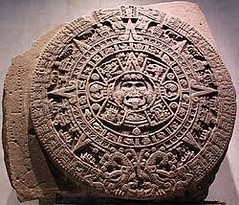 There are examples
from the most sophisticated security printers of the time, enhanced with vignettes, portraits and devices in deep intaglio from engraved hard-steel plates. There are also
delightfully crude cartones, some little more than diminutive scraps of paper or cardboard, often produced with the most ad hoc improvisations under conditions of
near-impossible hardship during battles, sieges, or simply lack of appropriate material for the purpose. And yet, here they are, surviving to testify to the indomitable
fortitude of Mexico and the will of its people.
There are examples
from the most sophisticated security printers of the time, enhanced with vignettes, portraits and devices in deep intaglio from engraved hard-steel plates. There are also
delightfully crude cartones, some little more than diminutive scraps of paper or cardboard, often produced with the most ad hoc improvisations under conditions of
near-impossible hardship during battles, sieges, or simply lack of appropriate material for the purpose. And yet, here they are, surviving to testify to the indomitable
fortitude of Mexico and the will of its people.
These spacious dimensions of the entire saga of Mexico are displayed in the sweeping iconographic panorama of its paper money. The details are the focus of this second edition, aided and abetted by more than forty contributors. This book has been previously reviewed in glowing terms by knowledgeable numismatists, and deservedly so. Its content, structure, scope, and numbering protocol have been perused and analyzed and amply commented on by other reviewers.
We see notes of the early eras, of the empires, and of the republican periods. There are sections segregated by states and municipalities, the bancos, the military, private issues, pre-Revolution, Revolution, and post-Revolution, ending in the 1970s with the American Bank Note Company issues of the modern Banco de Mexico. This second edition is encyclopedic in coverage of types and yet goes deep in detailing varieties. Building on the printed 2010 first edition, categories are amplified, date and series tables are extended. Prices are adjusted, generally upward, sometimes radically so. New discoveries are added to this kaleidoscope of paper money and each is a new thrill for the enthusiast. This 2nd edition is the indispensable reference work on the subject.
For more information, or to order, see:
Mexican Paper Money 2017 Book
(https://worldnumismatics.com/product/mexican-paper-money-2017-book/)
To read the earlier E-Sylum article, see:
NEW BOOK: MEXICAN PAPER MONEY 2017 EDITION (http://www.coinbooks.org/v20/esylum_v20n51a03.html)

MICHAEL METRAS (1943-2018)
Chicago Coin Club Secretary Carl Wolf submitted this obituary for Mike Metras, a longtime E-Sylum reader and occasional contributor. Thanks. Sorry to hear the news. I added a couple images found on his web sites. -Editor
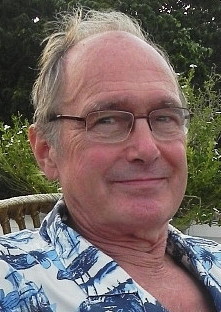 Michael Eugene Metras, age 75, passed away June
26, 2018 in Santa Fe, NM following a heart attack.
Michael Eugene Metras, age 75, passed away June
26, 2018 in Santa Fe, NM following a heart attack.
Mike was born January 16, 1943 in Watervliet, MI, moved to Woodstock, IL in 1953, attended Marian Central Catholic High School, graduated from college with a degree in classical languages.
In April, 1992, Mike joined the Chicago Coin Club becoming member #1030. He served on the Club Board, authored and co-authored several of the Club's souvenir currency sheets issued for the Chicago's Paper Money Expo and was an active exhibitor. Some of Mike's electronic publications and essays include: "Ethiopia: Travels of a Youth," "Mike's Morgans," "Trains on Currency and Stock Certificates," "Money Meanderings: An Introduction to Numismatics," and "Axum: Coins and Places." He was a member and web-master for the Hillside Coin Club and newsletter editor for the Elgin Coin Club. He will always be remembered as a knowledgeable numismatist willing to share and friend to all.
Mike enlisted in the U.S. Army, served in Phu Bai, Vietnam, and Asmara, Ethiopia. When he was discharged in 1970, he spent six months exploring East Africa and climbed Mt. Kilimanjaro. On his return to the U.S., Mike worked as Service Manager for White Motors Co. and traveled extensively in Latin and South America. He was also employed by Computer Associates as a Technical Writer. When he retired he began to pursue a lifelong dream of traveling and writing which began with a walk around Sicily.
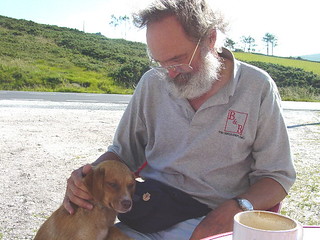 Over his life Mike learned Swahili,
French, Spanish, Italian, Latin, Greek and German which served him well on many pilgrimages. In 2003 he walked the 588-mile Spanish Camino De Santiago De Compostela (Way of St.
James). He walked segments of this pilgrimage 4 more times and met the love of his life Petra Wolf, an environmental engineer from Constance Germany. They married and embarked on
a 14-year odyssey of travel and many pilgrimages, including: walks across America, walk from Germany to Rome, walk from Southern Germany to Jerusalem, and a 23-month, 5,300-mile
walk from Southern California to Jerusalem which he recorded in the book "Encounters on the Road to Jerusalem." In 2013 they began an internal spiritual pilgrimage to
India.
Over his life Mike learned Swahili,
French, Spanish, Italian, Latin, Greek and German which served him well on many pilgrimages. In 2003 he walked the 588-mile Spanish Camino De Santiago De Compostela (Way of St.
James). He walked segments of this pilgrimage 4 more times and met the love of his life Petra Wolf, an environmental engineer from Constance Germany. They married and embarked on
a 14-year odyssey of travel and many pilgrimages, including: walks across America, walk from Germany to Rome, walk from Southern Germany to Jerusalem, and a 23-month, 5,300-mile
walk from Southern California to Jerusalem which he recorded in the book "Encounters on the Road to Jerusalem." In 2013 they began an internal spiritual pilgrimage to
India.
Mike is survived by his wife Petra Wolf, two brothers and three sisters. A celebration of his life was held July 15 in Santa Fe. True to the way Mike lived his life as a pilgrim, writer, traveler and wanderer, he requested his remains be cremated and, in lieu of flowers, his friends should to take someone they care about on a walk, long or short.
For information about Mike's life see his web sites PilgrimageCreations.com and WorksandWords.com .
Members who contributed to his obituary include CCC members Robert Feiler and Steve Zitowsky.
INVENTORY COPY OF EARLY PAPER MONEY OF AMERICA
The latest addition to the Newman Numismatic Portal is Eric P. Newman's inventory copy of his book, Early Paper Money of America. Project Coordinator Len Augsburger provided the following report. -Editor
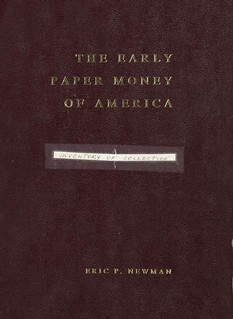 The Newman Portal recently
digitized a first edition copy of Early Paper Money of America. Published in 1967, the work was immediately the standard reference for colonial paper money. Although Newman
had a longstanding interest in early American currency, the “nail in the coffin” was his acquisition of the Harley Freeman collection in 1963 – with this reference collection in
hand, Newman was now virtually compelled to publish.
The Newman Portal recently
digitized a first edition copy of Early Paper Money of America. Published in 1967, the work was immediately the standard reference for colonial paper money. Although Newman
had a longstanding interest in early American currency, the “nail in the coffin” was his acquisition of the Harley Freeman collection in 1963 – with this reference collection in
hand, Newman was now virtually compelled to publish.
Newman made careful annotations in this first edition copy, recording his personal inventory in addition to numerous clarifications. Paper money is more traceable than coinage as issued notes were assigned serial numbers, so this document serves as an important pedigree record. Purchasers of colonial currency from the Newman sales may wish to compare their notes with this recently scanned Newman inventory.
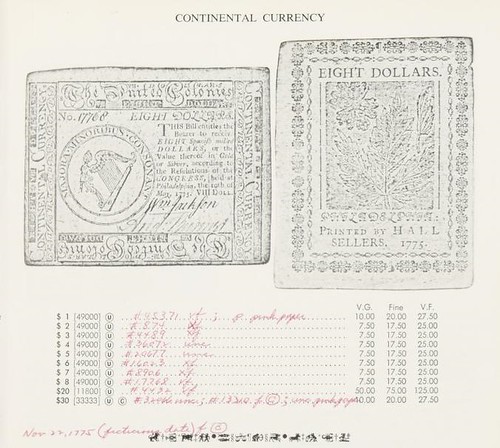
Interior page of inventory copy, listing May 10, 1775 issue of Continental currency in the Newman collection
Link to Early Paper Money of America (inventory copy) on Newman Portal:
https://nnp.wustl.edu/library/book/552738
EARLIER USES OF CIRCULATION/CIRCULATED CAMEO
Recently we discussed the term "Circulation cameo" (also "circulated Cameo" or "CircCam"). The earliest usage we'd found was in a 2007 Chicago Coin Club Chatter article. But our readers unearthed earlier examples. Thanks. -Editor
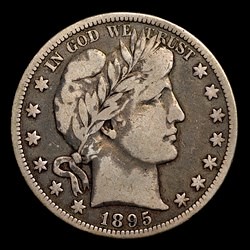
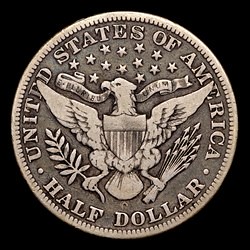
Robertson W. ("Rob") Shinnick writes:
I coined the phrase, you might say, on the Collectors Universe forums before 2006.
September 25, 2006
Hey, I just got a Draped Bust half that resembles yours, Tom! 'Bout the same grade, as I recall. And like yours, it's what I like to refer to as a "circulated cameo", meaning the devices are lighter than the fields. Mine has really dark grey fields- almost black. But the portrait and so on are lighter, which makes 'em stand out nicely.
I think "circulated cameo" should become a quasi-official numismatic term. If somebody else didn't coin the phrase before me, let it be known henceforth, that I, Lord M. Smartypants, created it here and now.
...or maybe it should be a "circulation cameo", to avoid confusion with lightly-circulated cameo proofs.
Yeah, that's the ticket.
From henceforth and now on, blahblahblah, Let It Be Known that I, Lord M. Smartypants, did hereby and blahblahblah, REcoin the term "Circulation Cameo", to refer to any business strike coin that has dark fields and light devices; to wit, a coin that received a cameo effect through wear (circulation), as opposed to a cameo proof coin.
So be it enacted. From now on, all such coins shall be referred to as "circulation cameos".
September 26, 2006
During a recent discussion of TomB's 1803 Draped Bust half, I coined a new numismatic phrase (I think): "circulation cameo".
This refers to a coin with darker-toned fields and light devices, like a cameo effect, but unlike a cameo proof, the circulation cameo achieved this cameo effect through wear on its high points. I have seen a number of Draped Bust silver coins with this look, and I like it. Even a silver coin that is so darkly toned it's almost black can be pleasing if the portrait and devices are a lighter color- the contrast of light and dark is pleasing to the eye.
OK, so maybe you don't like my new term, but such coins needed a short descriptor of some sort.
To read the complete thread, see: Show us your "circulation cameos"! (CircCam) (https://forums.collectors.com/discussion/542501/show-us-your-circulation-cameos-circcam)
Bill Nyberg writes:
On November 25, 2004, Andy Lustig posted this on the PCGS Forum!
November 25, 2004
Andy Lustig:
Take a look at ARCO's Barber halves. Some display a cameo effect every bit as much as gem proofs. It seems to me that it's inconsistent to designate proof cameos but not circ cameos. What do you think?
ccex:
I voted YES. Arco is one of my coin collecting heroes, and I try to build my 3 circulated Barber sets with the "circulated cameo" look that has made his set famous here. I know the Barber series best, but see the circulated cameo issue as an upcoming designation across all series of circulated U.S. coins.
As silly as it may sound, there are many other collectors who enjoy original circulated coins with light devices and darker fields. We can tell when a coin has been messed with, and so can PCGS. I am willing to pay a premium for a circulated cameo VF or XF Barber coin over the typical monochrome gray one in the same grade, so PCGS might actually consider the designation of Circulated CAM. It remains to be seen whether the circulated CAM designation carries enough of a premium to cover the grading fees on enough lower grade circulated coins (and I have some circ. CAM G-4s)
However, I think it will be tough to write the standard between circulated CAM and circulated DCAM, but I expect this will be attempted in the next five years. If there's one thing that numismatists have in common, it's the ability to discern minute differences between coins and tell each other how to distinguish them.
To read the complete thread, see: (https://forums.collectors.com/discussion/343184/poll-should-circs-be-designated-cam-and-dcam#latest)
Rob adds:
Now, I know I came up with the term independently of Andy (and maybe even before him), but since his 2004 thread predates my own earliest mention of the term that I can find (my 2006 thread about CircCams), it appears he should get the credit, as I have no evidence to back my claim to the term prior to 2006.
Doesn't matter so much. I just thought that appearance needed a shorthand term, and I'm glad to see it gaining some currency in the numismatic community.
I'm virtually certain I'm the first who abbreviated it as "CircCam", even if Andy used a conjunction of "circulated" and "cameo" before me.
So credit him, or both of us, if the historical origin of the term is important. It's all good, and I'm flattered either way. :-)
I've certainly promoted the use of the term since at least '06.
Andy Lustig adds:
I’ve always wanted to contribute something to numismatics. Never imagined this would be it!
Thanks to Lance Keigwin, Bill Nyberg, Rob and Andy for assistance with this article. I'll happily recognize both Andy and Rob as the earliest known users of the term. See Dick Johnson's VOCABULARY entry elsewhere in this issue. “Circulated Cameo” will appear in the next revision of his Encyclopedia of Coin and Medal Technology on the Newman Numismatic Portal. -Editor
To read the earlier E-Sylum articles, see:
VOCABULARY TERM: CIRCULATION CAMEO (http://www.coinbooks.org/v21/esylum_v21n29a21.html)
MORE ON CIRCULATION/CIRCULATED CAMEO (http://www.coinbooks.org/v21/esylum_v21n30a06.html)
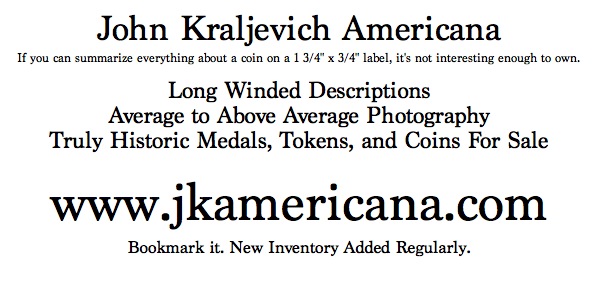
1945 ROOSEVELT PRESIDENTIAL SERIES MEDAL DESIGNER
Last week I asked about the designer of the obverse of the 1945 Franklin Roosevelt medal I chose for the NUMISMATIC NUGGETS article. Here's a recap of that discussion. -Editor
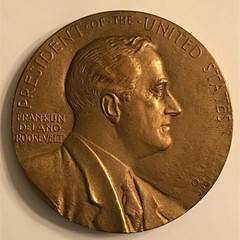
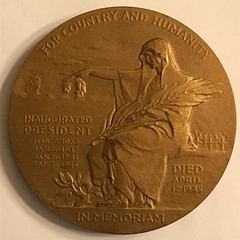
Description: 1945 Commemorative Medal To Honor President Roosevelt After He Died, the obverse reads For Country And Humanity ... Died April 12, 1945, In Memoriam, brass, 3 wide, 1/8 thick, crisp, hefty
The obverse is signed "J.R.G", and the reverse is signed SINNOCK. "SINNOCK" of course is U.S. Mint engraver John R. Sinnock. The 1945 Roosevelt Inaugural medal was done by Jo Davidson. So who is J.R.G.? -Editor
Joe Levine writes:
I agree that it looks like J.R.G. but I believe this "G" to be an awkward looking "S" This medal has always been ascribed (Both obverse and reverse) to Sinnock. Check with Bob Julian.
Dick Grinolds writes:
The Franklin Roosevelt commemorative medal you pictured in the last E-Sylum is actually the FDR medal from the Presidential Series struck and sold by the U.S. Mint. It is listed as Mint List No. 131 in the catalog "Medals Of The United States Mint Issued For Public Sale" published by The Department Of The Treasury. My copy has a 1969 date in the Foreward. The catalog details the U.S. Mint medals and lists the engraver(s) for each piece; it lists only John R. Sinnock as the artist for this medal.
I guess my first question would be "Are you sure that the initials are actually J.R.G.?" I don't have an example of the medal in stock currently to physically examine but the enlarged image on the auction page appears to me to be J.R.S. for John Ray Sinnock rather than J.R.G.
The long use of the Presidential series dies by the Mint as well as the relatively soft striking pressure can often cloud some of the smaller details. Dick Johnson can probably confirm that the obverse die is also a work by Sinnock.
Bob Julian writes:
The initials are clearly JRS. The S has the slight appearance of a G but is not. This time period is a little out of my area of interest but there is no question about the initials being JRS and standing for John Ray Sinnock.
So Sinnock it is! Thanks, everyone. -Editor
To read the earlier E-Sylum article, see:
NUMISMATIC NUGGETS: JULY 29, 2018 : 1945 Franklin Roosevelt Commemorative Medal
(http://www.coinbooks.org/v21/esylum_v21n30a25.html)
MINTMARKS SHOWN ON THE MINT BICENTENNIAL MEDAL
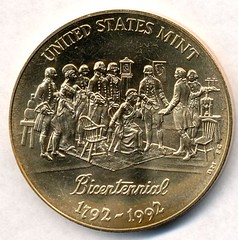
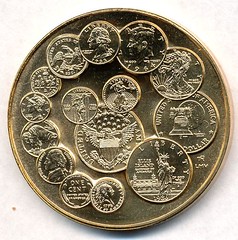
Regarding the Mint Bicentennial Medal based on the Dunsmore Painting, Jon Radel writes:
None of the mint staff in 1992 were around in 1792, but I suspect somebody on staff had been around in 1968, or at least paying attention to coins as a child, when they moved the mintmarks on quarters. If you look on the other side of the medal, you'll find a 1932 quarter with the mintmark on the obverse. Oops
Well, the design was done by a then-newbie to numismatic engraving, Tom Rogers. Here's how he describes his work on his web site. -Editor
U.S. Mint Bicentennial Medal Reverse
 Pictured here
is the reverse of the United States Mint Bicentennial Medal.
Pictured here
is the reverse of the United States Mint Bicentennial Medal.
My first assignment as a Sculptor / Engraver at the Mint was to re-arrange the elements of the Mint's internal competition winning entry.
When it was approved, I proceeded to carve backwards in the plaster negative, the entire fifteen coins on its face.
It was sort of a “Trial by Fire” for me, and an introduction of my style of work to the management at the U.S. Mint.
To read the complete article, see: U.S. Mint Bicentennial Medal Reverse (http://www.tdrogers.com/u-s-mint-bicentennial-medal-reverse/)
To read the earlier E-Sylum article, see:
NOTES FROM E-SYLUM READERS: JULY 29, 2018 : The Dunsmore Painting Mint Bicentennial Medal
(http://www.coinbooks.org/v21/esylum_v21n30a11.html)
READER THOUGHTS ABOUT BREEN AND COIN WORLD
ANA Edition reader Joe Scarlett writes:
Walter Breen is gone and should be forgotten.
Dave Hirt writes:
The post on Water Breen, Stanley Apfelbaum, and his ads in Coin World brought back memories to me. In 1975 I decided to sell most of my coins, and just collect numismatic literature. I chose Apfelbaum's firm to do that.
For some reason, even though there were other consigners, Apfelbaum, and/or Herb Melnick decided to name the sale catalog after me. Soon full page ads started to appear in Coin World, which was MUCH larger at that time. At first I was thrilled to see my name in such bold print but after the 3rd or 4th week, I started to be a bit embarrassed by all that publicity.
However name recognization seems to long endure. A year or two ago my brother from California was deer hunting in Kansas. At a dinner he started to speak with a man next to him. The man asked his name, and he said Ralph Hirt. The man asked about his family, and was told. "I have a brother David" The man then said "Oh, the rich coin collector!!" My brother answered, "Well, I guess Dave is doing ok, but I don't think he is rich.
Great story. Breen may be gone, but he and Apfelbaum were pretty unforgettable characters. Direct memories fade and disappear as generations die off. In the end all we'll be left with are a few physical artifacts and the written word. -Editor
Len Augsburger of the Newman Numismatic Portal writes:
Following up on David Alexander's note in the last E-Sylum regarding Breen's use of “piece de merde” in Coin World - an examination of issues from 1965 indicates that Breen's final installment in the ”Bristles and Barbs” column was in the August 18, 1965 issue, titled “Collectors Should Beware in Buying Treasure Gold.” A check of that and several columns previous did not reveal the existence of “merde,” or any other vulgar language. While there is no reason to doubt Alexander's memory of his discussion with Coin World staffer Jay Guren, the story may be apocryphal.
To read the earlier E-Sylum articles, see:
BEARDLESS BREEN ON RADIO WITH 1943 BRONZE CENT (http://www.coinbooks.org/v21/esylum_v21n30a08.html)
WALTER BREEN AT COIN WORLD AND BEYOND (http://www.coinbooks.org/v21/esylum_v21n30a09.html)
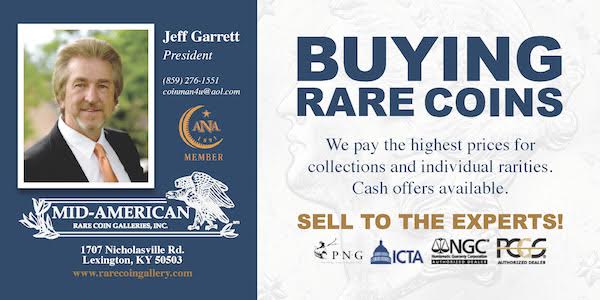
ENGRAVER JAMES SMITHERS
Christopher R. McDowell, Editor, Journal of Early American Numismatics (JEAN) submitted these thoughts on early American engraver James Smithers. Thank you! -Editor
I write to comment on the July 15, 2018 E-Sylum. I read the following regarding James Smithers and what I believe was a plea for assistance from readers having more information:
• The Continental Congress conducted a majority of its materials-based business in the Philadelphia area, and its paper money, from A to Z, was produced by local tradesmen. Though David Rittenhouse supplied the first 36 "cutts" 30 for the Continental Currency plates in 1775, we don't know who supplied those employed for the February 1776 fractional bills. However, other convenient options existed. Philadelphia had many of the best engravers and metalworkers in 18th-century America, like James Smithers, who made cuts for some currency issues.
Other highly skilled mechanics, like silversmith Joseph Richardson, produced the dollar-size 1756 "Kittanning Destroyed" and the 1757 "Treaty of Easton" medals, the first such items struck in British America. Even the dies Richardson used were Philadelphia-made, from the hand of clockmaker Edward Duffield. One might wonder why the Continental Congress would turn to Gallaudet in New York City, a hundred miles and a few days' travel away, when it had a plethora of more talented craftsmen with a greater array of skills right in its backyard.
I am, coincidentally, conducting research on Pitt Tokens, which were allegedly engraved and/or struck by James Smithers. My research will be presented next year in JEAN Issue No. 3. Without getting too much into Pitt Tokens or Mr. Smithers connection to them, I wish to comment on Mr. Smithers’ suitability as a potential candidate to have worked for the Continental Congress as an engraver. It is true that Mr. Smithers was a gifted engraver – far more gifted than your readers are perhaps aware. His skill set, in my opinion, puts him on par with Paul Revere and Abel Buell. Smithers, like these men, was a master of all forms of engraving and excelled in the rococo style popular during the period. With this skill he engraved the plates for some Pennsylvania currency emissions; even placing his name on the 40 shilling notes of 1775 and 1776.
The part of James Smithers’ life that has not been discussed before is that he was a notorious Tory and counterfeiter. Indeed, his loyalty to the crown was such that he was charged under a bill of attainder by the Pennsylvania legislature for high treason in June 1778 for aiding and assisting the British. This aid came in the form of counterfeiting Pennsylvania notes during the British occupation of Philadelphia. As the original artist of some of the plates for these notes, he was uniquely qualified to copy them. He escaped the hangman's noose by fleeing Philadelphia under British military escort to New York City, then under British occupation.
In 1779, he advertised his engraving skills in Rivington's Royal Gazette – a New York City Tory paper. Instead of returning to Philadelphia after the war, Smithers was transported by the Royal Navy along with his entire family (wife, 9 children, and 2 servants) to Port Roseway, Nova Scotia.
As a high-profile Tory charged with treason, Smithers must have questioned his life in the hands of Washington's Army after the British left New York and did not want to chance fate. It was not until it became clear there would not be any violent retribution against Tories for their conduct during the war that he returned to Philadelphia in 1786.
Smithers originally came to America circa 1768 from England and died circa 1799. Your readers and other researchers can make of this information what they will, but I have found no evidence that James Smithers, Sr. or Jr. were employed by the Continental Congress in 1776. Should my research uncover any connection between Smithers and the Continental Dollar or Continental paper currency, I will be sure to update everyone. If I am in error in any of my facts, I hope someone will take the time to correct me as my research is still under way.
To read the earlier E-Sylum article, see:
NEXT STEPS FOR CONTINENTAL DOLLAR RESEARCH (http://www.coinbooks.org/v21/esylum_v21n28a19.html)
NOTES FROM E-SYLUM READERS: AUGUST 5, 2018
Elias Gervais 1721-1791?
Regarding Elias Gervais and the Continental Dollar, last week Bill Eckberg wrote:
My concern about Gervais is that he died in 1777 and the Continental Currency pieces don’t appear to have been made before 1783. My opinion on these remains consistent, but I don’t think Gervais is the smoking gun that some see him to be.
Julia Casey writes:
I wanted to point out that there are sources that indicate his date of death was 1791 (not 1777).
Thanks. Julia provided this translation via Google. -Editor
The audience is informed that the wine auction of Herr Geheimer Rath Hebron at Trier, which had already been announced on the 2nd of November, was set for 2 pm on the 7th of November, 1791.
In the afternoon, Herr Elias Gervais, Geneva, and Pettscherstecher at Neuwied, died So he endeavored to have his engraving tools and instruments taken over by Geneva and Engraver by profession. He flatters all those who respect him with their courtesy
To read the original source, see: Politische Gespräche der Todten über die Begebenheiten ..., Volume 2; Volume 6
There is also this. -Editor
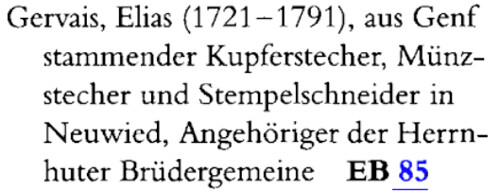
Anfang 1773 – Ende Oktober 1775
Thanks, everyone, for your contributions. It will be interesting to see what turns up next. -Editor
To read the earlier E-Sylum article, see:
MORE ON CONTINENTAL DOLLAR RESEARCH : More on the German Connection
(http://www.coinbooks.org/v21/esylum_v21n30a07.html)
U.S. Mint Green Box Dollar Certificate
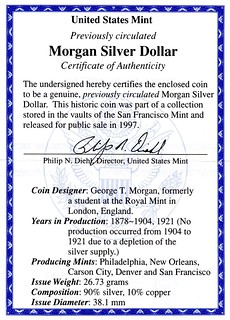 Bruce Bartelt
writes:
Bruce Bartelt
writes:
I purchased some of the silver dollars that were sold from the San Francisco Mint in November 1997. They came with a certificate of authenticity (see attached). I have a single Morgan dollar in the green box and a pair of a Morgan and Peace dollars in a red box. Unfortunately, unlike the so-called "GSA" dollars they are not sealed in a special case but come in a generic plastic capsule - so it would be possible to switch coins (if anyone cared enough to do so).
Thanks - I hadn't seen these certificates before. -Editor
To read the earlier E-Sylum article, see:
NOTES FROM E-SYLUM READERS: JULY 29, 2018 : Morgan Dollars and Mint Display Boxes
(http://www.coinbooks.org/v21/esylum_v21n30a11.html)
More on the Alderman Gold Nugget Medal
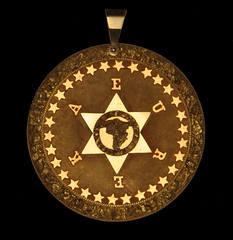
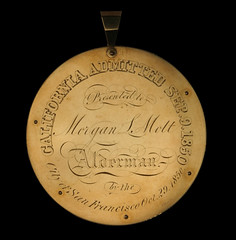
City of San Francisco to Morgan L Mott, Alderman - Gold Nugget Medal
Saul Teichman writes:
Here is some additional information related to the California medal presented to the Alderman. When Stack's sold the medal in the Ford XX sale, it appears the original Brand journal number was lost over time.



Thanks. Great documentation! -Editor
Agreeing with Rex Stark and Alan Weinberg on another topic in that article, Michael Wehner writes:
The 1851 "engraved" medal is a well known fake of the 1970s. These turn up on eBay with some regularity.
To read the earlier E-Sylum article, see:
NOTES FROM E-SYLUM READERS: JULY 29, 2018 : Answer: San Francisco Committee of Vigilance Medal
(http://www.coinbooks.org/v21/esylum_v21n30a11.html)
Query: Windau Study of the 60 Pesos of Oaxaca Sought

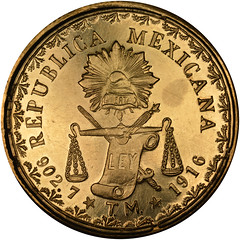
Adrián González-Salinas writes:
I read a note published in The Numismatist (April 1942, Page 333) entitled: "Names of Owners of 60 Pesos of Oaxaca Wanted" by Edmund Hower Windau (* 22 July 1886 Watson, PA | + 26 December 1964 San Antonio, TX).
There, he commented that he had made a study of the gold 1916 60-pesos Oaxaca pieces (KM-755) and he believed the Howland Wood's (1877-1938) estimate of 21 coins was accurate. So, he wanted to determine how many 1916 gold 60-pesos of Oaxaca, Mexico could be accounted for.
Would any E-Sylum readers know if Edmund H. Windau published his study?
Great question. His name doesn't sound familiar, but perhaps our readers can help. Anyone? Thanks. I inserted images of the coin from the NGC World Coin Price Guide. -Editor
Flavors of the U.S. Mint
Gawain O'Connor writes:
Did the Family Circus cartoon remind anyone else of the Marx Brothers' 1933 film "Duck Soup" where they discuss the government of Freedonia? From the scene, Secretary of War:
Firefly (Groucho): ...How would you like a job in the mint?
Chicolini (Chico): Mint? Ah, no. I no like-a mint. Ah, what other flavor you got?
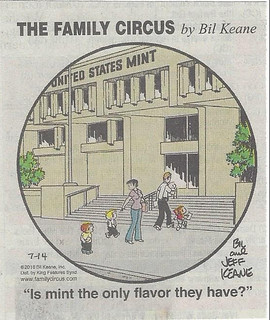
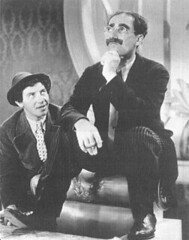
I didn't remember that line. Old jokes never die, they just get recycled. -Editor
For more information on the scene, see:
The Marx Brothers Duck Soup - Secretary Of War
(http://www.marx-brothers.org/whyaduck/info/movies/scenes/secofwar.htm)
The Kitty Litter Method
Regarding musty books, Bruce Bartelt writes:
The late John Burns once told me he used the cat litter method to eliminate the smell; I haven't tried it myself though.
Worth a try. It can't hurt. -Editor
To read the earlier E-Sylum article, see:
http://www.coinbooks.org/v21/esylum_v21n29a17.html : On Treating Musty-Smelling Books
(http://www.coinbooks.org/v21/esylum_v21n29a17.html)
Egging Your Coins
In the but-it's-not-even-Devil's-night-department, Craig Sholley writes:
In the April 1870 Mason's Coin and Stamp Collectors' Magazine, the term "Egged" was described as "covering the surface of a coin with the white of eggs to protect it from rust or corrosion."
Here are a few follow-up comments on this from an email exchange Craig kicked off with this observation. -Editor
Brad Karoleff writes:
I did this to help "preserve" my neighbors car once......
Dave Bowers writes:
Hmmm. Hadn’t heard about that. Mason was perhaps the most off-the-wall of the late 19th century dealers.
Johnn Kraljevich writes:
Albumen (or "glaire") was used for a lot of different purposes in the 19th century. It's sort of hard and glossy when it dries and I could totally see someone coating coins with it. It's no stupider than thinking that dipping coins in olive oil is helpful.
Mark Borckardt writes:
AU Details, Egged NGC
Query: U.S. Quarter Information Sought
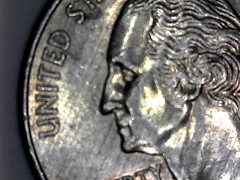
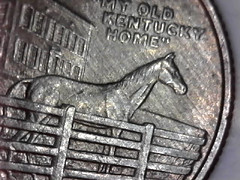
2001-P Kentucky State Quarter
Web site visitor Terry Toler writes:
I am new to coin collecting after a discussion on a 20 dollar star note. I found this Quarter in my change jar when I started looking for error coins. I joined two online coin groups, United States Error Coins and Coin OPPS.
I posted the quarter in United States Error Coins and only got a like with no feedback. Then I posted in Coin OPPS and there Pete Apple gave some insight as to what I was looking at, and spent many hours researching articles on what he said may be "Planchet Striations". The articles were very informative but still left the question unanswered after reading about the pressure of the strike between the hammer and anvil dies.
So I started looking at suggested sites like Variety Vista and Error-Ref.com. The closest I could find were what they called "rays". Then that started another search for many hours using the key words like "rays on coins". I finally saw a video on state quarter error collections, and lo and behold the last coin was a quarter he had that looked like it had sun rays on it and he mentioned the word "Trails".
Now the search was on again. I searched with key words like "trails on coins" with only a few hits and articles. Then after reading one article that called them "Die Trails", I used the key words "Die Trails" and that search opened up many more web sites.
I read a article "Unravel the Mysteries of Die Trails" on Coin World then I found another article, "The Theory of Trail Formation" published by Traildies and this I how I came to contact you. After looking at pictures on your web page this was the closest as to what I was seeing on the quarter.
Thanks for reaching out. That's quite a quest. Congratulations on sticking with it. The web is chock full of great information, but finding what you want can be a daunting task sometimes.
We've only had one article on Trail Dies, the piece linked below by Jeff LaPlante. I'll try to put Terry in touch with Jeff. Meanwhile, would any readers have additional thoughts, information or suggestions about Terry's quarter? To me, those lines are too plentiful to be Trails; my own guess would be planchet striations, but I'm no expert in these things. Thanks. -Editor
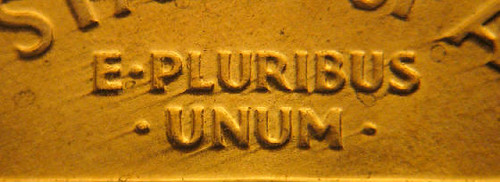
Trail die
Web references:
United States Error Coins Facebook Group (https://www.facebook.com/groups/1404131066535437/about/)
Coin Opp Facebook Group (https://www.facebook.com/pg/CoinoppYouTube/about/)
Variety Vista (http://www.varietyvista.com/)
Error-Ref.com (http://www.error-ref.com/)
Unravel the mystery of die trails: Inside Coin World
(https://www.coinworld.com/news/us-coins/2017/07/unravel-mystery-surrounds-die-trails-inside-cw.all.html)
The Theory Of Trail Formation (http://www.traildies.com/the-theory-of-trail-formation/)
To read the earlier E-Sylum article, see:
NUMISMATIC VOCABULARY: TRAIL DIES (http://www.coinbooks.org/esylum_v13n02a11.html)

BOOK CUTTING ANSWER: VETUSTA MONUMENTA
E-Sylum readers are simply amazing when it comes to knowing or knowing how to find numismatic information of all kinds. Among the most prolific of these are Julia Casey and Ron Haller-Williams, whom I earlier dubbed our "Googler-in-Chief". They both came through with a spot-on answer to David Pickup's question on the origin of this book cutting he found tipped into another book. Thanks!! -Editor
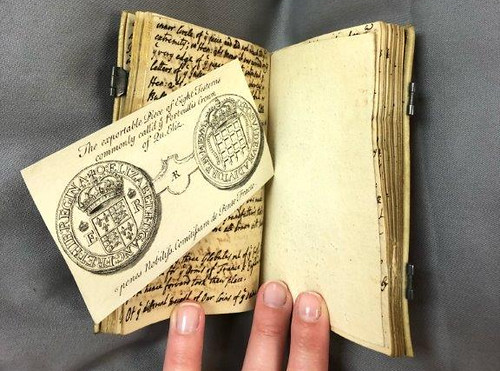
Ron was the first to report his discovery, and Julia was close on his heels. Their answer? The book cutting comes from Vetusta Monumenta, a seven-volume work on ancient buildings, sites, and artifacts published in Latin. -Editor
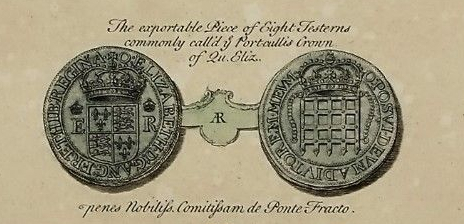
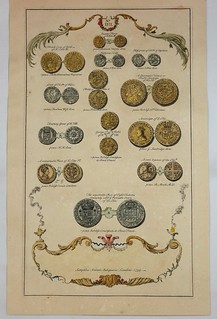
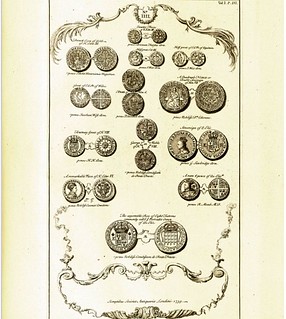
Left: Ron's Find; Right: Julia's Find. Click on links below for full images
For Ron's reference, see:
https://i.ebayimg.com/images/g/KPUAAOSww85acENd/s-l1600.jpg
For Julia's references, see:
Vetusta monumenta : quae ad rerum britannicarum memoriam conseruandam / Societas antiquariorum Londini sumptu suo edenda
curavit. (https://catalog.hathitrust.org/Record/100807769)
https://babel.hathitrust.org/cgi/pt?id=mou.010014268400;view=2up;seq=224;size=150
They make this look easy. So how do they DO this magic, anyway? Bruce Bartelt had an inkling. -Editor
Bruce Bartelt writes:
I have some book cuttings that a friend in my local club gave me. Mine have text on the back and a simple Google Books search using a phrase from the text quickly turned up an exact match with The History of England, by Rapin de Throyas (translated by N. Tindel, 3rd Edition 1743). It also illustrates the portcullis coin that Mr. Pickup's cutting shows, but is a different engraving. So that would be an avenue to pursue should there be any text on the back of Mr. Pickup's cutting.
Excellent idea! Web search is an amazing tool. That's what led Julia and Ron to nail down the culprit. Here's Ron's detailed account. -Editor
Bob Van Arsdell seems to have been right when he ended up with "It's possible the book may not have been a numismatic one", based on his earlier comment that "the coin was well-known by the 18th Century, so it didn’t warrant the elaborate title if was included in a plate of many coins in a numismatic work."
However, he was wrong in guessing that it "could be an in-line plate in a page of text".
In fact, it is a full-page plate, see https://i.ebayimg.com/images/g/KPUAAOSww85acENd/s-l1600.jpg
It is/was plate lvi (56) of Volume I of "Vetusta Monumenta ..." (Society of Antiquaries of London, published 1747 though the plate is dated 1739) - and also in Volume 1 of Lord Oxford's collection (which I haven't yet tracked down, unless it's the sale catalogue).
See https://en.wikipedia.org/wiki/Vetusta_Monumenta and https://en.wikipedia.org/wiki/Society_of_Antiquaries_of_London
In "NOTES FROM E-SYLUM READERS: MARCH 26, 2017" you labelled me as "Googler-in-Chief" !!! Well, explorations like this can be very hard work - this is how I did it.
I noticed that the caption starts with "the exportable piece of eight ...".
1: Google this, for BOOKS (WITH the quotes, which mean "exact phrase"): "the exportable piece of eight"
2: This gives one hit - investigate! It is referenced on page 358 of Volume 70 of the Walpole Society, (re)published/digitized 4 Nov 2008.
3. The reference-number "811" looks significant, so search the book for this number - it also appears on p.395.
4: Now Google this: "Walpole Society" Volume 70
5: The first hit is https://www.jstor.org/stable/i40086491
6: Go there (click on the heading of the "hit"): The Table of Contents shows: GEORGE VERTUE AS AN ENGRAVER (pp. 207-517) by David Alexander at https://www.jstor.org/stable/41830020
7: Go there (click on the link).
8: Click on the "Read Online (Free)" button.
9: If not already logged in, either log in or sign up (free to access up to 6 articles per month).
10: Use the "thumbnails" tab to navigate to p.358.
11: Take a good look at this reference and the preceding one (811 & 810). Observe that there is a reference to "Lord Oxford": This would be Edward Harley, 2nd Earl of Oxford and Earl Mortimer (1689-1741), see https://en.wikipedia.org/wiki/Edward_Harley,_2nd_Earl_of_Oxford_and_Earl_Mortimer not his son, the 3rd Earl, who immediately sold off the collections! [Do not confuse with the Earl of Orford, e.g. the 4th Earl, Horatio "Horace" Walpole (1717-1797).]
12. Note that the previous reference (810) mentions "a gold coin of mary queen of scots" so make a note of this.
13. See also p.394 & 395 - we see that (as expected) we want Plate 56 of Volume 1, originally issued at price one shilling and three pence (£0.0625 or $0.25).
14: See also the "References" tab, and scroll down to read the bits on "Vetusta Monumenta" and "Walpole, 1762".
15: Google the phrase from step 12, and get lucky!
16. Click on the first hit, to find somebody selling the plate on eBay for $39.99, item #173129496294
17. Note the date of the engraving (1739), and use this in step 19.
18. Click on "Visit store".
19. Search that eBay store for: COINS 1739
20. One of the four hits is what we want, so click on it: item #173129489368 "Coins Struck in France and Flanders Relating to England - QUARTER FLOREN -1739"
21: See also https://books.google.co.uk/books?id=ntc_AQAAMAAJ&pg=PA418
So: It is the lowest piece illustrated on a full-page plate is by George Vertue. These plates were available both loose (this one was £0.0625) AND bound or gathered into a volume (for some 11.4% more than the individual total).
P.S. To find out more about this engraver, try https://en.wikipedia.org/wiki/George_Vertue
He was official engraver to the Society of Antiquaries. Additionally he produced a numismatic work which deserves to be better known than it is: Medals, coins, great seals, and other works of Thomas Simon, engraved and described by George Vertue. Printed by J. Nichols, printer to the Society of Antiquaries. (1780 - 27 pages), see https://books.google.co.uk/books?id=yWAGAAAAQAAJ&printsec=frontcover#v=onepage&q&f=false
Wow! Thanks for the detailed account, and all your hard work. This is a great example for other researchers. -Editor
To read the earlier E-Sylum articles, see:
NOTES FROM E-SYLUM READERS: JULY 22, 2018 : Query: Book Cutting Identification Sought
(http://www.coinbooks.org/v21/esylum_v21n29a17.html))
BOOK CUTTING IDENTIFICATION THOUGHTS (http://www.coinbooks.org/v21/esylum_v21n30a10.html)
MORE ON NUMIS-MAILRS
Pete Smith writes:
I was interested in David Gladfelter's report on the Numis-Mailrs that he has preserved. I am attaching images of two that I have because the imprinted names are people important to the collection of large cents.
I met Myles Z. Gerson in 1979 and he died in 1986. He was an important collector of large cents, most notably 1794, and Conder Tokens. Although young collectors may not be aware of him, he was noted for using these mailers back when he was alive.
I also met John D. Wright in 1979. He took the Gerson mailers and added his own imprint. I have seen John in recent years and I believe he is still living.
Here are Pete's images. Thanks! -Editor
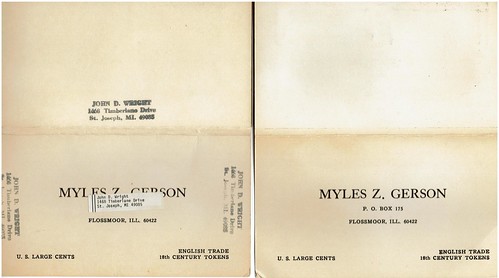
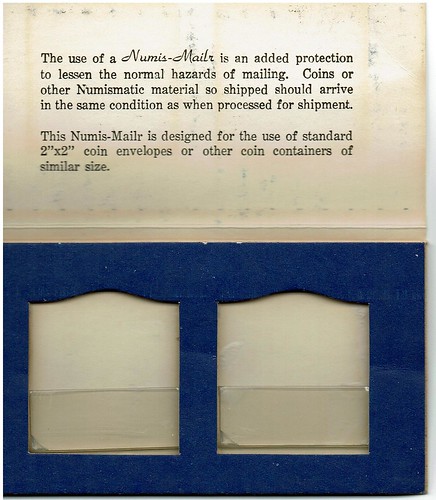
To read the complete article, see:
NUMIS-MAILRS (http://www.coinbooks.org/v21/esylum_v21n30a13.html)
QUERY: ANACS GRADER IDENTIFICATION SOUGHT
Robert Rightmire writes:
As in the past, The E-Sylum is loaded with important information. Your service to all of us is deeply appreciated. I'm really pleased that Rex Stark stepped in with his fountain of knowledge.
I have an inquiry for our readers: The ANACS type 8 certificate, issued in Dec. 1986 and Jan.1987, lists the grading opinions of four graders. Might anyone know the identity of the graders? It is assumed that there were several. How many coins might have been graded over this two-month period? Most examples seen are for silver dollars. Any information on minor denomination coins, with type 8 certificates, would be appreciated.
Great question. Robert provided the below images. Thanks. Can anyone help? -Editor
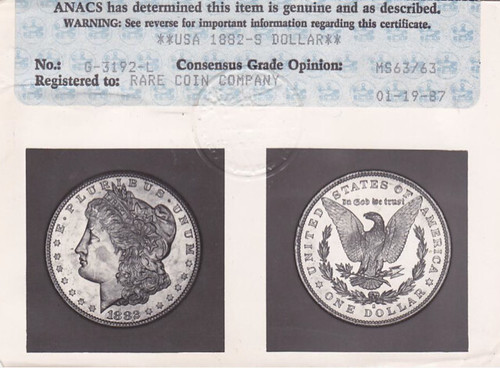
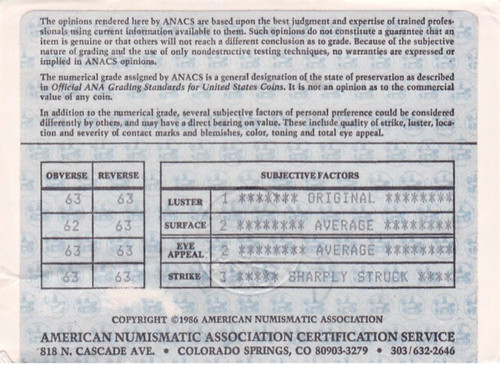
To read the earlier E-Sylum articles, see:
PNG AUTHENTICATION CERTIFICATES (http://www.coinbooks.org/v21/esylum_v21n30a12.html)
NOTES FROM E-SYLUM READERS: JULY 22, 2018 : PNG Authentication Certificates
(http://www.coinbooks.org/v21/esylum_v21n29a17.html)
MORE BREEN AND TAXAY AUTHENTICATION CERTIFICATES (http://www.coinbooks.org/v21/esylum_v21n28a12.html)

2018 ANA WORLD'S FAIR OF MONEY EVENTS
In addition to the NBS events mentioned earlier in this issue, here are some that readers have suggested. -Editor
Exhibits
Paul Hybert submitted this reminder about the exhibit area at this month's ANA convention. I'm planning to visit - this is one of my favorite parts of the event. -Editor
The Collector Exhibits Area at the ANA's "World's Fair of Money" in Philadelphia has a wide range of collector exhibits for your enjoyment. Use the online Exhibit Guide, located at http://www.chicagocoinclub.org/events/2018/ana/ex/all_by_cl.html to see a list of the exhibits, arranged over 20 different exhibiting classes. Look for a few exhibits ahead of time, or drop by and look at them all!
This online Exhibit Guide will be updated with corrections and changes so that the final version will list all exhibits that are present when the area opens to the public on Tuesday.
We are conveniently located to the left as you enter the bourse, before you get to the NBS, Charlie Davis, or Kolbe & Fanning booths.
It looks like a great lineup. There are three exhibits in the Numismatic literature class this year. -Editor
The Elongated Collectors
Bob Fritsch writes:
The Elongated Collectors (TEC) will occupy Table 554 beside the Kid's Zone at the Philadelphia 2018 World's Fair of Money. Many items will be offered including the usual ANA and TEC coins and sets, plus special coins for the 50th annual ANA Summer Seminar in 2018, and memorial coins for Eric P. Newman and Ed Rochette. Badges suspended from a ribbon will also be available in both enameled and uncolored varieties.
 The enameled badge (pictured) is rolled on a
1776-1976 Bicentennial Quarter, while the uncolored one is on a Pennsylvania 50 States Quarter. Quantities are limited so pre-orders, closing 9 August, are recommended. Go to the
TEC Store link at https://tecnews.org/store/ and click on Pre- order in the left side. Use code ILLBETHERE18 at checkout to pick up at the show and save the shipping
cost.
The enameled badge (pictured) is rolled on a
1776-1976 Bicentennial Quarter, while the uncolored one is on a Pennsylvania 50 States Quarter. Quantities are limited so pre-orders, closing 9 August, are recommended. Go to the
TEC Store link at https://tecnews.org/store/ and click on Pre- order in the left side. Use code ILLBETHERE18 at checkout to pick up at the show and save the shipping
cost.
You can also roll coins of your choice (up to half dollar size) at the table. Visit us and create your own souvenir of the show. And consider joining THE FUNNEST CLUB IN NUMISMATICS. See you there!
J.N.T. LEVICK INDUCTED TO ANA HALL OF FAME
Joseph N.T. Levick has been inducted into the American Numismatic Association's Hall of Fame. -Editor
In an effort to enshrine the most important collectors, scholars and hobby professionals of all time, the ANA maintains the Numismatic Hall of Fame at its headquarters in Colorado Springs, Colorado. Individuals are recognized annually, with “modern” numismatists named in odd years and “historic” personages in even years. In June 2018, the ANA welcomed to this elite group a notable hobbyist of days gone by—Joseph N.T. Levick (1828-1908).
Born in New Orleans, Levick began collecting coins after he moved to Philadelphia in 1855. In 1860 he relocated to New York City, where he established a numismatic store at the corner of Broadway and 20th Street. During the Civil War, Levick was a Union soldier in the 70th regiment of New York volunteers, attaining the rank of first lieutenant. He was a founding member of both the Philadelphia Numismatic Society (1858) and the New York Numismatic Society (1864).
Levick served the American Numismatic Society (ANS) as treasurer (1867-74), and in 1866 he launched its American Journal of Numismatics, the first numismatic periodical in the United States. The October 1868 issue carried Levick's first article, “A Table, Showing the Prices Paid for the Five Types of the 1793 Cent, Selected from Twenty of the Principal Coin Sales in the Country, from 1855 to 1868.” He found it difficult to describe the pieces adequately, which led him to present in the April 1869 issue the first photographic plate of coins known in American numismatics. The image showed obverse and reverse die varieties, with lines connecting die pairs. Although just 100 original copies of the well-known “Levick Plate” were produced, it has been reprinted several times.
The American Journal of Numismatics was a costly endeavor, and in 1868 Levick convinced the ANS to explore other avenues of publication. Two years later, the Boston Numismatic Society agreed to oversee the journal's production, taking it from monthly to quarterly, and reducing its annual subscription from $3 to $2.
Levick joined the ANA in July 1906. He died in September 1908, three weeks after his 80th birthday. Levick's contributions to numismatics will be recognized at the ANA's Annual Banquet during the Philadelphia World's Fair of Money.
For more information, see:
PAST HALL OF FAME INDUCTEES BY YEAR (https://www.money.org/numismatic-hall-of-fame)
VOCABULARY TERMS: CAMEO
Dick Johnson submitted these entries from his Encyclopedia of Coin and Medal Terminology. Thanks. -Editor
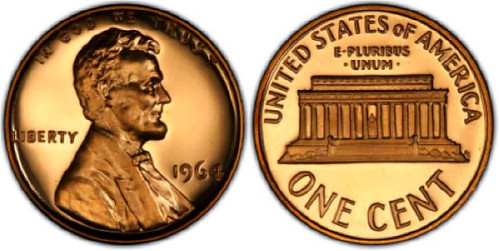
1964 Proof Red Cameo Lincoln Cent; Image courtesy PCGS
Dick writes:
Inspired by the articles in The E-Sylum the last few weeks on “Circulated Cameo” as a vocabulary term you will find here other cameo terms used in numismatics. “Circulated Cameo” will appear in the next revision in the Newman Portal. The term meets the criteria for use in the numismatic field; it accurately describes the status of such a coin, plus it is understandable by anyone.
Cameo. A medallic item in raised relief similar to gem or shell cameos. Medallic cameos are almost always oval shape (usually vertical oval – see OVAL MEDAL), mostly of portraits, and often handcut. Gem cameos, cut in onyx or sardonyx, or shell cameos with layers of colors where the relief design is cut in the top layer in contrast to its background layer in a different color. Cameos – of all kinds – are always in raised relief.
Cameo engraving. Historically cameo engraving thrived alongside coin engraving, as branches of the same glyptic art. Coin engravers, however, cut INTAGLIO (in iron dies to strike positive coins). Cameo engraving, on the other hand, cut positive RELIEF images in gemstones and shells by the engraver; there was no intent to reproduce the design, the engraved cameo was the end product.
Cutting a cameo die by engraving is easier than cutting an intaglio die. The design – in the positive – is constantly in front of the engraver; it does not require frequent proving to inspect the state of the work. Cameo engraving requires BACKGROUND CUTAWAY, removing DEAD METAL (the unwanted metal) from the diestock leaving intact the positive image. Once completed it requires HUBBING to make a working die to strike positive pieces.
The technique developed from primitive drills; early bow instruments provided power to the drill, later power was provided by a treadle, still later by water-wheel power. The drills and wheels were fed with a slurry of diamond dust and oil which aided the cutting. Today power grinders can easily remove gross metal, but it is still the hand burin that does much of the intricate detail work.
Some early cameos were of scenes, often mythical or religious, but portraits predominated nearly all cameo creations. Cameo medals, like the series illustrated, exhibit typical portraits.
Cameo engraving was often an apprenticeship for developing sculptural talent. The great Italian artist Benvenuito Cellini is noted for his cameos, his coins and medals, in addition to his renowned metalwork and sculpture. As a student Augustus Saint-Gaudens cut cameo gem portraits before attempting sculpture (and later, coins and medals), while medallist Victor D. Brenner cut cameo dies before learning the technique of modeling oversize medallic models and having these pantographically reduced.
Cameo relief. All cameos of modern times are in relief (and only a rare ancient cameo was intaglio). Cameo relief in a sunken area – COELANGLYPTIC RELIEF – is called chevee or cuvette in French. Thus cameo cutting always had the design in positive in front of the engraver (unlike diecutting in the negative).
Cameo portrait. A trend among collectors in the last decade or two of the 20th century has been the use of the term “cameo” to describe the portrait device on a proof or uncirculated coin. The Franklin Mint issued a series of such cameo medals.
Cameo art illustrations. Monochrome graphic illustrations (two-dimension) of bas-relief are often called cameos. They are shaded in such a way to indicate the
rises and falls of relief. Such cameo illustrations are called camaieu. The French named the shades of gray toning of these cameo illustrations: grisailles (there is
no comparable English term).
CLASS 01
REFERENCE:
X5 {1991} MILLER.
Cameo Die. A handcut die of raised relief (positive), opposite of intaglio die. Hand engravers find cutting a cameo die far easier because the positive image is always in front of them (then after completion, the cameo die is HUBBED to make a striking die). Cameo diecutting requires a greater amount of BACKGROUND CUTAWAY but does not have to be constantly PROVED by the engraver (in contrast to intaglio die engraving where the hand engraver likes to make quick SPLASHERS to check newly cut detail). Typically cameo diecutting would be the device only; lettering would be added by letter PUNCHES after the positive cameo die would be hubbed into a negative working die.
The term cameo die also refers to any die to strike a CAMEO, as a small medal die, usually oval shaped, and irrespective of its being hand cut or reduced from models cut on a
die-engraving pantograph. See OVAL MEDAL.
CLASS 04.1
Cameo Incrustation. A type of glass ornamentation molded of portraits and other devices from medals. See SULPHIDES.
CLASS 14
Cameo Medal. An oval medal in raised relief usually bearing a portrait, in similitude to a carved shell cameo.
CLASS 02.12
Cameo Relief. Raised relief, particularly a small relief handcut with BACKGROUND CUTAWAY. Handcut dies are often cut in cameo relief in contrast to negative carving of
INTAGLIO, because the image is constantly in positive relief before the engraver and it does not have to be proved to check the state of the work. See RELIEF, CAMEO DIE.
CLASS 03.2
Looking for the meaning of a numismatic word, or the description of a term? Try the Newman Numismatic Portal's Numismatic Dictionary at: https://nnp.wustl.edu/library/dictionary
Or if you would like a printed copy of the complete Encyclopedia, it is available. There are 1,854 terms, on 678 pages, in The Encyclopedia of Coin and Medal Technology. Even running two a week would require more than 19 years to publish them all. If you would like an advance draft of this vital reference work it may be obtained from the author for your check of $50 sent postpaid. Dick Johnson, 139 Thompson Drive, Torrington, CT 06790.

DR. GEORGE PETER FRENCH, MD (1865-1932)
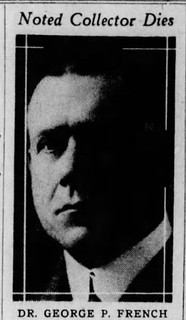 Dr. George
Peter French, MD (1865-1932), was born in 1865 at Rochester, Monroe County, New York son of Irish Catholic immigrants John French (1820-), a contractor, and Bridget French
(1830-1902). His parents came to America in 1850 settling at Rochester, New York. His mother was famous as a noted inventor of over 36 objects of utility including : a steam
sterilizer, various patented medicines and remedies and a burglar proof lock.
Dr. George
Peter French, MD (1865-1932), was born in 1865 at Rochester, Monroe County, New York son of Irish Catholic immigrants John French (1820-), a contractor, and Bridget French
(1830-1902). His parents came to America in 1850 settling at Rochester, New York. His mother was famous as a noted inventor of over 36 objects of utility including : a steam
sterilizer, various patented medicines and remedies and a burglar proof lock.
In 1872, at age seven he began collecting coins and obsolete paper money.
In 1875, he began collecting art which later on included works by Rembrandt, Raphael, Turner, Evans and Reynolds.
He graduated Rochester Public School, and the Cathedral High School.
Later on he began collecting guns including flintlocks, matchlocks, and wheel-locks. Among the flintlocks was one issued by the Committee of Safety before the Revolutionary War. He also collected many and varied curiosities including a valuable rare stamp collection, a Friesland hooded clock made circa 1558, Venetian blown glass, Egyptian mummies, Louis XV furniture, and the Barnum Mermaid exhibited by Phineas T. Barnum in his circus.
In 1888, he married Mary A. Donnelly.
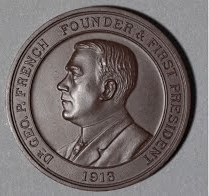 In 1889, he graduated Columbia
Medical College, and lived at 234 Adams Street, Rochester.
In 1889, he graduated Columbia
Medical College, and lived at 234 Adams Street, Rochester.
He began his practice at St. Mary's Hospital, Rochester, New York.
He joined the ANA in December 1910 and is ANA member No. 1457
French amassed an extensive collection of stamps, coins, and antiques over his lifetime. His large cent collection which was broken up and sold through sales by four coin dealers : first, U. S. Coin Co. on December 5, 1917 who sold 110 large cents, second, combined with Gilette and Fred B. King of 1058 lots sold through Henry Chapman, Jr., 47th sale on December 19, 1927 which comprised some 98 large cents, third, a group of 830 large cents were sold by B. Max Mehl in 1930 through fixed price lists, and fourth, Barney Bluestone held a sale on February 17-18, 1933, which contained 549 of his cents.
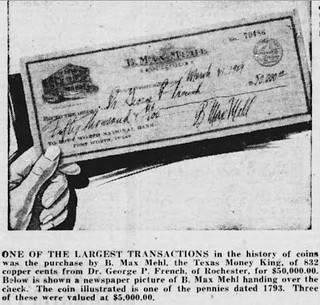 The group held by B. Max Mehl were reported in his obituary in the Democrat and Chronicle, as having been
sold to Mehl directly from Dr. French in 1929 for $50,000. Many of French's large cents were purchased by T. James Clarke and Henry Sternberg. He also had a prized 1853-O half
dollar without arrows.
The group held by B. Max Mehl were reported in his obituary in the Democrat and Chronicle, as having been
sold to Mehl directly from Dr. French in 1929 for $50,000. Many of French's large cents were purchased by T. James Clarke and Henry Sternberg. He also had a prized 1853-O half
dollar without arrows.
He died of pneumonia on Friday, November 25, 1932.
To read the complete article, see:
FRENCH, DR. GEORGE PETER
(https://sites.google.com/a/numismaticmall.com/www/numismaticmall-com/french-dr-george-p)
The entire inventory of the Lupia Numismatic Library is for sale. Individual items will be available before the remaining archives are broken up into parcels sold at philatelic auctions in the U. S. and Hong Kong. Check NumismaticMall.com frequently as dozens of new items with estimates will be posted daily until everything is sold.
All inquiries will be given prompt and courteous attention. Write to: john@numismaticmall.com .
NEW DEALER PROFILE: JEREMY BOSTWICK
E-Sylum supporter Jeremy Bostwick of Numismagram submitted these thoughts on being a young dealer in today's hobby. Thanks! -Editor
 I noticed the “New Collectors and
New Dealers” article in the previous week's E-Sylum, and thought that I would contribute my perspective on the youth movement in our graying hobby.
I noticed the “New Collectors and
New Dealers” article in the previous week's E-Sylum, and thought that I would contribute my perspective on the youth movement in our graying hobby.
Like most of us in coins, I began collecting U.S. around the age of seven, with a few Morgan dollars and a Red Book from my grandfather. As my interest increased beyond my allowance, I learned the Red Book forwards and backwards, and added other books to my collection---literature being the easier buy.
Years later, while looking for some part-time work during college, I started working at the neighborhood coin shop at which I spent many of my younger years admiring coins which I couldn’t possibly acquire. Very quickly, I fell in love with being on “the other side” of the counter, and eventually was fortunate enough to get a job with Classical Numismatic Group, where I moved from US and paper money to ancient coinage.
My knowledge of that area grew, and I then took a job with Atlas Numismatics, switching again to a more modern world coin inventory. Finally, I attempted to control my own destiny within the hobby by focusing even more upon building my numismatic library and fostering the ability to catalog remotely from Pennsylvania (now California), which I currently do for Numismatik Naumann in Vienna.
At that time, I also decided to begin building my own inventory of numismatic items, many of which are medals owing to my growing interest in the underappreciated area of medallic art.
“Numismagram” was started with the idea of addressing the problems presented in the aforementioned article---how does someone young start in this business? (a business which is so dependent upon cash flow and a customer base who knows who you are). Throughout my time in this business, I saw how instrumental longstanding relationships with customers were in creating connections.
With social media, my idea was to bridge the gap between a beginning numismatic enterprise and a potential collecting base (hence, the name, a nod to Instagram). While I’m not sure that we’re there yet, it's definitely been a great way to reach those to whom you may otherwise have had no way of presenting your material. Also, mirroring the comment about wholsesaling, it's definitely a decent part of my business, but I am establishing more and more of a retail side to my operation as well, and my website (numismagram.com) is steadily getting increased views, allowing me to turn over inventory a bit faster and acquire even more new items on a regular basis. Attending and setting up at some of the larger coin shows has also served as a great way to get my name out there to other dealers and customers alike who may have known me from working with someone else in the past to now taking a crack at it on my own.
Jeremy's recent trip to Peru provided social media fodder and content for his email Newsletter #8, where I found this great medal illustrated. -Editor
This Swedish medal, commemorating the 75th Anniversary of the Nitroglycerin Corporation, does a pretty good job at painting the picture of how these Incan constructions were produced---human labor, and a great deal of human labor at that.
To read the earlier E-Sylum article, see:
WHAT'S NEXT FOR THE RARE COIN BUSINESS? : New collectors and New Dealers
(http://www.coinbooks.org/v21/esylum_v21n29a11.html)

CIVIL WAR MUSEUM SEEKS HODGES BANK NOTE DETECTOR
Can any of our readers help? The American Civil War Museum would like to borrow for display a copy of Hodges’ New Bank Note Delineator. -Editor
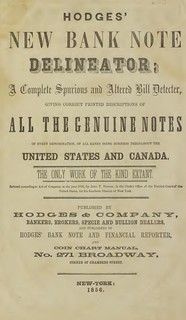 The American Civil War
Museum in Richmond, Virginia, is seeking an original volume of Hodges’ New Bank Note Delineator (1856) for the temporary exhibition, Greenback America, that will run
from March 2019 to March 2020. The volume should be in good condition and will be displayed open, and editions from other years will be acceptable. Contact Chris Graham, Guest
Curator, at cgraham@acwm.org .
The American Civil War
Museum in Richmond, Virginia, is seeking an original volume of Hodges’ New Bank Note Delineator (1856) for the temporary exhibition, Greenback America, that will run
from March 2019 to March 2020. The volume should be in good condition and will be displayed open, and editions from other years will be acceptable. Contact Chris Graham, Guest
Curator, at cgraham@acwm.org .
From the museum web site, “The mission of The American Civil War Museum is to be the preeminent center for the exploration of the American Civil War and its legacies from multiple perspectives: Union and Confederate, enslaved and free African Americans, soldiers and civilians.”
For more information about the museum, see:
https://acwm.org/
BEAUREGARD STATUE TIME CAPSULE OPENED
Anne E. Bentley of the Massachusetts Historical Society and Dick Hanscom forwarded this Daily Mail article about the discovery and opening of a time capsule in the base of a statue of General Beauregard. Thanks. See the article for many more pictures. -Editor
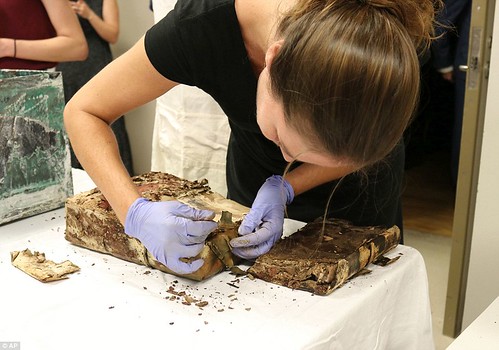
Turn-of-the-century tour books, lots of Confederate cash, a post-Civil War medal from a Union veterans' group, and a flag too tattered by time to tell whether it was U.S. or Confederate were among items removed Friday from a 1913 time capsule buried beneath a Confederate monument.
The statue of the Confederacy's first general, P.G.T. Beauregard, was among four Confederate monuments removed last year. Its pedestal was removed last week.
Stuck to the pedestal's bottom was a copper box — a time capsule holding some items dating back to the Civil War.
When the box and pedestal were separated, the box was open, according to Lt. Gov. Billy Nungesser. He spoke at a news conference as the box's damp, musty contents were unpacked for the first time.
Two private conservators carefully removed each artifact or piece of an artifact. A flag at the top came out in clumps too delicate to unfold.

There were Confederate $5 and $10 bills, Louisiana bills of several denominations, including an uncut sheet of a dozen $5 bills dated Oct. 10, 1862; $10 bills from Mississippi, and several bonds, including a City of New Orleans bond for $1,000 with about a dozen $30 coupons still attached.
To read the complete article, see:
Time capsule from 1913 buried under a statue of Confederate General P.G.T
Beauregard, that was torn down in New Orleans, is opened and reveals a trove of Civil War cash, medals, newspapers and coins
(http://www.dailymail.co.uk/news/article-6025643/Time-capsule-reveals-cash-flags-more.html)
AUDIO: COINWEEK INTERVIEWS HEIDI WASTWEET
I gave this CoinWeek podcast a listen during my evening commute earlier this week, and I highly recommend it. Charles Morgan does a great job interviewing Citizen Coinage Advisory Committee member and sculptor Heidi Wastweet. -Editor
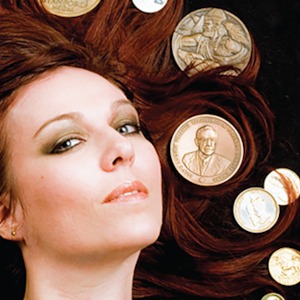 Heidi Wastweet is an
award-winning medallic artist.
Heidi Wastweet is an
award-winning medallic artist.
Over the course of her 30-year career, she has designed more than 1,000 coins, medals, and tokens, mostly for private mints.
From 2010 to 2018, Heidi sat on the CCAC, where she, along with other members of the art community and general public, deliberated on the direction of American coin and medal design.
If you have purchased a coin or medal from the U.S. Mint made within the past eight years, odds are that Heidi had a role to play in the design process.
What is the state of coin and medal design in America and what can be done to improve upon it?
We ask Heidi these questions and more, this week on the CoinWeek Podcast.
To listen to the complete podcast, see:
CoinWeek Podcast #103: Coin Design Highs and Lows with Heidi
Wastweet (https://coinweek.com/coinweek-podcast/coinweek-podcast-coin-design-highs-and-lows-with-heidi-wastweet/)
In related news, a Coin Update article by Brandon Christopher Hall published July 31, 2018 reports that the CCAC has unanimously rejected the reverse designs submitted for the 2018 American Innovation $1 coin. -Editor
Today's public meeting of the Citizens Coinage Advisory Committee (CCAC) centered on the design of a dollar coin proposed to be the first minted under the American Innovation $1 Coin Act. The program's coins are scheduled to share a common Statue of Liberty design on the obverse. The CCAC focused more on which of the eight designs submitted for the reverse was to be recommended to the secretary of the Treasury. Round dissatisfaction with the portfolio prompted a motion to not recommend any of the reverse designs to Treasury Secretary Steven Mnuchin. The motion passed unanimously, 10-0, and various committee members voiced their dissatisfaction with the reverse designs, the proposed obverse design, and the program in general.
Member Dennis Tucker, the committee's numismatic specialist, pointed out that the legend on the reverse of the 2018 coin designs, mandated by legislation, may be misleading, since the name of the program is “American Innovation” and not “American Innovators,” the latter of which is to be inscribed on the coin. He contends that this narrowing of focus may limit designs to specific people who are innovators and not larger ideas or themes about American innovation that can be expressed on coinage. “Making the coin's legend consistent with the language of the legislation is Copywriting 101,” said Tucker, who serves as publisher for Whitman Publishing, LLC, which releases the annual Guide Book of United States Coins. “Innovations aren’t necessarily physical. If a state or territory innovated in a non-physical way—for example, it was the first state to allow women to vote; or it innovated in religious freedom—then innovators isn’t the right word.” He pointed out that innovation isn’t limited to inventions or patents, but could be philosophical, cultural, artistic, linguistic, social, creative, or otherwise intangible, and not necessarily requiring a single person as innovator.
Donald Scarinci, the senior member of the committee, voiced his disappointment toward the portfolio, saying that it was “not just a failure to the hobby community, but a failure to the greatest country on Earth.” Scarinci also drew a comparison between American coin designs and foreign coin designs, noting that the former tends to be outdone by the latter. In a bold move, he called for a collector boycott of the program.
To read the complete article, see:
The CCAC unanimously rejects the reverse
designs submitted for the 2018 American Innovation $1 coin
(http://news.coinupdate.com/the-ccac-unanimously-rejects-the-reverse-designs-submitted-for-the-2018-american-innovation-1-coin/)
Here are a couple of the rejected designs. -Editor

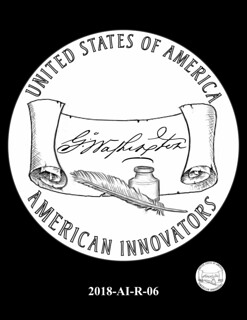
To see the complete set of proposed designs, see:
CCAC Meeting Images for the 2018 American Innovation $1 Coin Program
(https://www.usmint.gov/news/ccac-meetings/2018-american-innovation-dollar-coin)
And here's CoinWeek's take on the debacle. -Editor
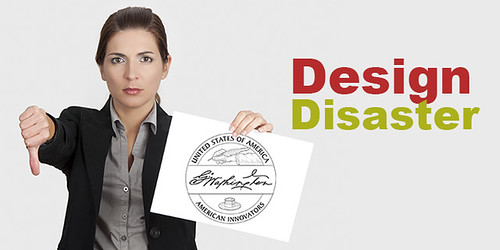
Please, make it stop!
Put before the Citizens Coinage Advisory Committee (CCAC) on Thursday, July 31 was a portfolio of designs for the first coin of an ill-conceived new supposedly circulating commemorative coin series that will be produced over the course of the next decade and a half by the United States Mint.
Luckily for the hobby and the public at-large, the CCAC soundly rejected these designs with a unanimous 10-0 vote. Had the final tally been 100-0 against, the proposed designs would not have received a sufficient rebuke.
To read the complete article, see:
Make it Stop: Perhaps Worst Conceived US Coin Design
Candidates Revealed (https://coinweek.com/us-mint-news/make-it-stop-perhaps-worst-conceived-us-coin-design-candidates-revealed/)
The CCAC performs a vital role for our nation's coinage. There are vacancies on the committee, and applicants are being sought. One needn't be a sculptor - there are seats reserved for numismatists and the general public. Consider serving to lend your expertise. For more information, see this Coin Update article. -Editor
To read the complete article, see:
Request for applications for appointment to the
Citizens Coinage Advisory Committee (http://news.coinupdate.com/request-for-applications-for-appointment-to-the-citizens-coinage-advisory-committee-2/)
LOCAL PAPER INTERVIEWS JEANNE STEVENS-SOLLMAN
Another longtime member of the Citizens Coinage Advisory Committee is Pennsylvania artist Jeanne Stevens-Sollman, who was interviewed for a story by a reporter for the Centre Daily Times. Here's an excerpt. See the complete article online, and be sure to watch the accompanying video. -Editor
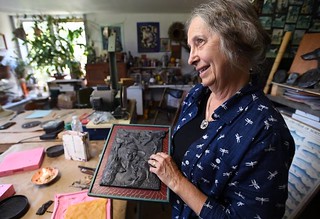 Jeanne Stevens-Sollman was
at one of those swinging medallic art conferences that you hear so much about, where the shop talk flows like champagne and bedtime is but the faintest whisper of a
suggestion.
Jeanne Stevens-Sollman was
at one of those swinging medallic art conferences that you hear so much about, where the shop talk flows like champagne and bedtime is but the faintest whisper of a
suggestion.
“The dialogue can go on to 2 a.m. in the morning, just about metals, about design,” Stevens-Sollman, an artist working in Bellefonte, said.
She was doing some light grumbling about the state of the state quarters, which aside from one or two exceptions appeared to her to be entirely overwrought, a bunch of images and information smashing up against each other without much room leftover for clarity.
Now in the middle of her second four-year term, she's might be the only person in a room full mostly of historians that looks at designing a coin in the same way that a poet might approach a haiku.
“You have a small space, you have to put a lot of information in it concisely,” Stevens-Sollman said.
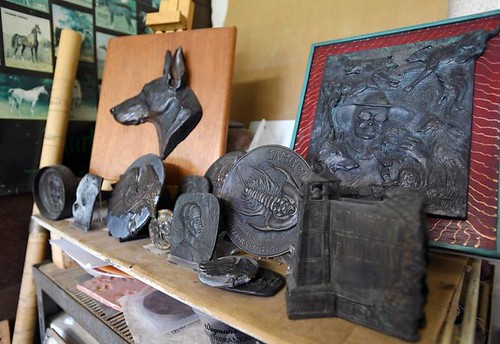
To read the complete article, see:
https://www.centredaily.com/living/article215084545.html
(https://www.centredaily.com/living/article215084545.html)
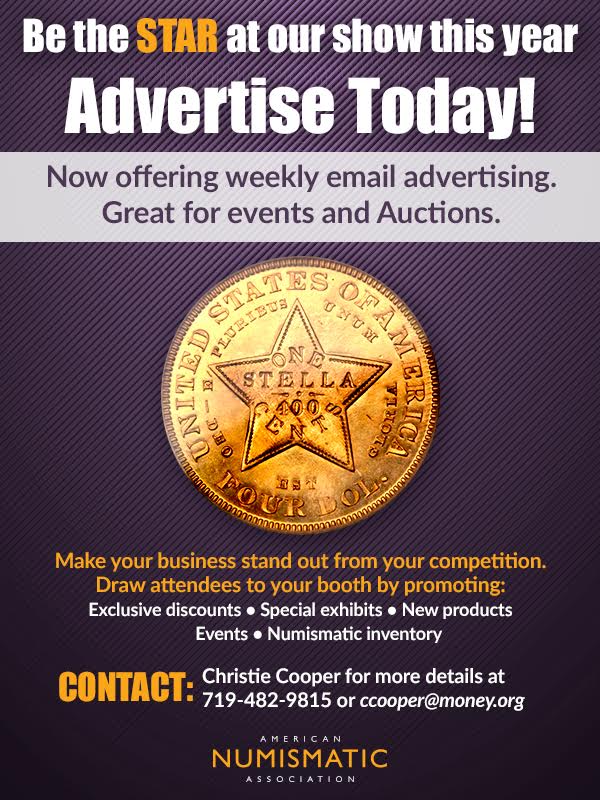
1792 WASHINGTON PRESIDENT GOLD EAGLE PROVENANCE
The Fall 2018 issue of Intelligent Collector from Heritage features an article titled "George's Coin" (pp 28-22) describing the 1792 Washington Gold Eagle Pattern piece in the upcoming sale of coins from the Eric P. Newman collection. The final page of the article has a summary of the coin's illustrious provenance, which I'm publishing here with permission. -Editor
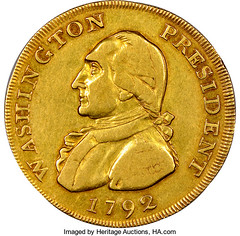
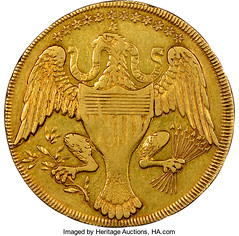
In the 75 years Newman held this and other numismatic treasures, he opined the 1792 Washington President gold eagle was struck expressly for, given to, and carried by President Washington. The provenance is singular in its importance (see “Long Line of Legendary Owners”), shedding light on why Newman held this prized possession in such high regard.
Long Line of Legendary Owners
Since 1855, only eight collectors have owned the 1792 George Washington gold eagle. Dates following each collector's name indicate the time of ownership, when known.
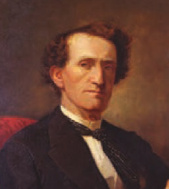 • Gustavus Adolphus Myers, Richmond, Va.,
1855-1860: First owner of record of the 1792 Washington gold eagle. While prior provenance is unknown, there is a possibility that the coin passed from grandfather to father
to son. Gustavus Myers was the son of Samuel Myers, who was born in New York City on April 16, 1755, and the grandson of influential New York silversmith Myer Myers, who was
active in freemasonry, and who was almost certainly acquainted with President Washington.
• Gustavus Adolphus Myers, Richmond, Va.,
1855-1860: First owner of record of the 1792 Washington gold eagle. While prior provenance is unknown, there is a possibility that the coin passed from grandfather to father
to son. Gustavus Myers was the son of Samuel Myers, who was born in New York City on April 16, 1755, and the grandson of influential New York silversmith Myer Myers, who was
active in freemasonry, and who was almost certainly acquainted with President Washington.
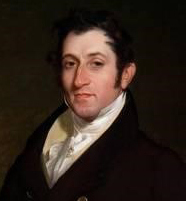 • Col. Mendes I. Cohen, Baltimore, 1860-1875:
Cohen acquired the coin apparently as a gift from Gustavus A. Myers. The Myers family of merchants and the Cohen family of bankers likely had a close business relationship. There
may also have been a family relationship, as Gustavus Meyers was the grandson of Elkaleh Cohen, who married Myer Myers.
• Col. Mendes I. Cohen, Baltimore, 1860-1875:
Cohen acquired the coin apparently as a gift from Gustavus A. Myers. The Myers family of merchants and the Cohen family of bankers likely had a close business relationship. There
may also have been a family relationship, as Gustavus Meyers was the grandson of Elkaleh Cohen, who married Myer Myers.
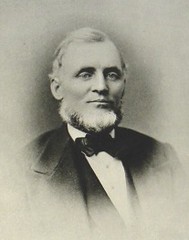 • Lorin G. Parmelee, Boston, 1882-unknown: Parmelee
was a Vermont-born businessman who started the first baked bean business in Boston. He acquired the Washington gold eagle, probably from Ebenezer Locke Mason, who had offered it
for sale in June 1882 for $500.
• Lorin G. Parmelee, Boston, 1882-unknown: Parmelee
was a Vermont-born businessman who started the first baked bean business in Boston. He acquired the Washington gold eagle, probably from Ebenezer Locke Mason, who had offered it
for sale in June 1882 for $500.
• Dewitt Sheldon Smith (unknown-1908): Smith, president of the Smith Paper Company, formed a first-class collection of Colonial coins and territorial issues, holding on to his coins until his death in Lee, Mass., in 1908.
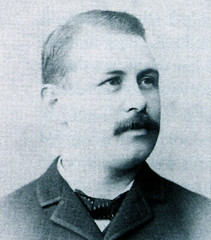 • Virgil M. Brand (1908-1926): Brand made
his mark as the first president of the United States Brewing Company. He then founded the Brand Brewing Company in 1899 and became a millionaire at an early age. He acquired
Smith's collection intact from his estate in 1908 and listed the 1792 Washington gold eagle as journal number 46483, noting it as “GW pocket-piece.”
• Virgil M. Brand (1908-1926): Brand made
his mark as the first president of the United States Brewing Company. He then founded the Brand Brewing Company in 1899 and became a millionaire at an early age. He acquired
Smith's collection intact from his estate in 1908 and listed the 1792 Washington gold eagle as journal number 46483, noting it as “GW pocket-piece.”
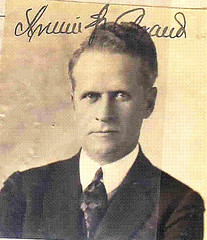 • Armin William Brand (1926-1933): Virgil never
married and did not leave a will, so his estate was divided between brothers Horace and Armin. Armin was awarded the Washington gold eagle as part of his share of the estate and
in 1933 sold it to New York coin dealer Wayte Raymond, who promptly resold the coin to his most important client, “Colonel” E.H.R. Green. Green paid over $2,500 for it, an unheard
of sum in his day.
• Armin William Brand (1926-1933): Virgil never
married and did not leave a will, so his estate was divided between brothers Horace and Armin. Armin was awarded the Washington gold eagle as part of his share of the estate and
in 1933 sold it to New York coin dealer Wayte Raymond, who promptly resold the coin to his most important client, “Colonel” E.H.R. Green. Green paid over $2,500 for it, an unheard
of sum in his day.
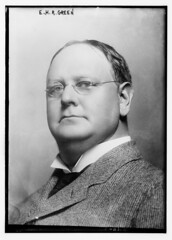 • “Colonel” Edward Howland Robinson Green
(1933-1936): The son of wealthy businesswoman Hetty “Henrietta” Green, he inherited her vast fortune and began collecting stamps, coins, art and other objects. At Green's
private radio station, Eric P. Newman was part of a group of Massachusetts Institute of Technology students who monitored and sometimes assisted with transmittals from Admiral
Byrd's first Antarctic expedition (a connection that would indirectly facilitate Eric's purchases from Green's estate).
• “Colonel” Edward Howland Robinson Green
(1933-1936): The son of wealthy businesswoman Hetty “Henrietta” Green, he inherited her vast fortune and began collecting stamps, coins, art and other objects. At Green's
private radio station, Eric P. Newman was part of a group of Massachusetts Institute of Technology students who monitored and sometimes assisted with transmittals from Admiral
Byrd's first Antarctic expedition (a connection that would indirectly facilitate Eric's purchases from Green's estate).
• Green Estate (1936-1942): “Colonel” Green's estate was administered by the Chase National Bank in New York. His numismatic holdings remained intact until Eric P. Newman negotiated the purchase of some Missouri paper money in 1939. Afterward, the bank over a period of years sold much of the collection to the partnership of Eric P. Newman and Burdette G. Johnson.
• Eric P. Newman and Burdette G. Johnson, 1942: After his initial success in acquiring items from the Green Estate, Newman formed a partnership with his mentor, St. Louis dealer Burdette G. Johnson, to purchase the bulk of the nonU.S. gold portion of the Green Collection. Eric provided the contacts with the estate and Johnson supplied the funding. The partnership acquired the 1792 Washington gold eagle in 1942, and Eric selected the coin shortly afterward as part of his share of the profits.
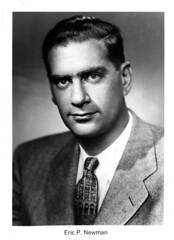 • Eric P. Newman (acquired July 1942): Newman
became interested in coins at the age of 9 when his grandfather gave him an 1859 Indian cent. Numismatics became a lifelong passion and he formed one of the greatest coin
collections of all time. He passed away in 2017 at the age of 106. His collection is being dispersed through an ongoing series of sales by Heritage Auctions. For more on Eric P.
Newman and his collection, see Truth Seeker: The Life of Eric P. Newman, by Leonard Augsburger, Roger W. Burdette and Joel Orosz.
• Eric P. Newman (acquired July 1942): Newman
became interested in coins at the age of 9 when his grandfather gave him an 1859 Indian cent. Numismatics became a lifelong passion and he formed one of the greatest coin
collections of all time. He passed away in 2017 at the age of 106. His collection is being dispersed through an ongoing series of sales by Heritage Auctions. For more on Eric P.
Newman and his collection, see Truth Seeker: The Life of Eric P. Newman, by Leonard Augsburger, Roger W. Burdette and Joel Orosz.
To read the earlier E-Sylum article, see:
NEWMAN'S 1792 WASHINGTON PRESIDENT $10 GOLD EAGLE (http://www.coinbooks.org/v21/esylum_v21n24a18.html)
To read the complete lot description, see:
1792 '$10' Washington Gold Eagle
Pattern, Musante GW-31 (A), Unique, XF45 ? NGC...
(https://coins.ha.com/itm/colonials/1792-10-washington-gold-eagle-pattern-musante-gw-31-a-unique-xf45-and-9733-ngc/a/1278-5010.s)
To read the complete multipage catalog, see:
https://www.heritagestatic.com/c/d/cms/260/443/1278-newman-catalog.26044368.pdf
ITALIAN COIN EXHIBIT AT FALL 2018 LONG BEACH
This press release describes an exhibit of Italian coins planned for next month's Long Beach show. -Editor
Historic Italian Coins at Long Beach

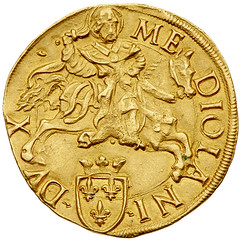
Doppio Ducat of King Louis XII
Famous gold and silver coins of Italy from the acclaimed Tyrant Collection, ranging from Gelon, tyrant of the cities of Gela and Syracuse in 485 BC, to King Victor Emmanuel III in 1933, will be publicly displayed together for the first time anywhere, September 6-8, 2018.
The unprecedented exhibit, “Tyrants of the Tyrrhenian and Adriatic Seas,” will be a featured attraction at the September 2018 Long Beach Coin, Currency, Stamp & Sports Collectible Expo in Long Beach, California.
There are 365 historic coins in the $8 million display celebrating numismatic treasures from Sicily on the south to Turin on the north. The exhibit is divided into regions by their boundaries with bodies of water, such as the Arno and Po rivers, and the Adriatic and Tyrrhenian seas, and showcases some exceedingly rare issues.
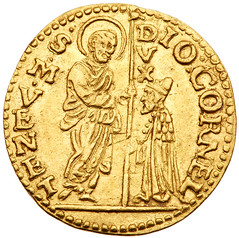
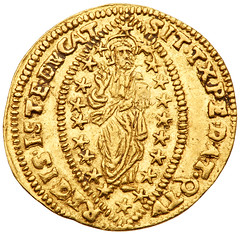
Zecchino of Giovanni I. Corner
“This part of the extensive Tyrant Collection, the world's most valuable rare coin collection in private hands, encompasses the expansive area that evolved into modern Italy. The impressive coins in the exhibit range from frequently seen ancients to medieval and modern issues of great rarity,” explained Ira Goldberg President of Goldberg Coins and Collectibles, Inc. (www.GoldbergCoins.com) in Los Angeles, California. Goldberg is one of the numismatic professionals providing guidance in assembling the wide-ranging collection.
“It is a massive collection that vividly depicts the generations of rulers who held sway in their respective regions of old Italy,” said Bruce Lorich, who cataloged the exhibit.
Among the many high-quality rarities in the display are gold Ducats and Zecchino of the Venetian Doges, including Giovanni Dandalo, Giovanni I. Corner and Francesco Contarini, and a Doppio Ducat of the French King Louis XII when he was the Duke of Milan from 1499 until his death in 1512. The Venetian gold Ducat collection is complete, and the exhibit features the only complete set in private hands of every Doge of Venice who struck a gold Ducat.
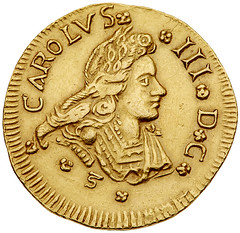
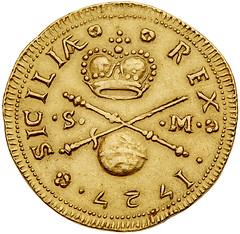
1727 King Carlos III 4 Ducati
The extensive array of Sicilian coins in the Tyrants of Charybdis section of the exhibit includes an ancient gold 100 Litrae of Dionysios I and a rare gold 1727 4-Ducati of Carlo III of Palermo.
The owner of The Tyrant Collection wants to remain anonymous while he shares the collection's coins with the public for their educational value. This is the third exhibit in a planned multi-year series of different displays at the Long Beach Expo.
Visitors to the September 2018 Long Beach Expo exhibit (booth #807) can receive a free, illustrated educational booklet about this latest, amazing display. Detailed catalogs with information and illustrations about each coin in the “Tyrants of the Tyrrhenian and Adriatic Seas” exhibit will be available for $10 each.
The Long Beach Expo will be held in the Long Beach, California Convention Center at 100 S. Pine Ave. Public hours are Thursday and Friday, September 6 and 7, from 10 am to 7 pm, and Saturday, September 8, from 10 am to 5 pm.
For more information on the Tyrant Collection, see:
http://thetyrantcollection.com/
For more information on the Long Beach show, see:
http://www.longbeachexpo.com/
COUNTERFEIT COIN EXHIBIT AT 2018 ANA WFOM
This press release outlines an educational exhibit of counterfeit coins and other numismatic items planned for the upcoming ANA World's Fair of Money. -Editor
Homeland Security loans items to illustrate levels of deceptiveness, diversity
The Industry Council for Tangible Assets Anti-Counterfeiting Task Force will exhibit a five-case display of counterfeit coins, precious metals bars, and grading holders during the American Numismatic Association's World's Fair of Money Aug. 14-18 at the Pennsylvania Convention Center in Philadelphia.
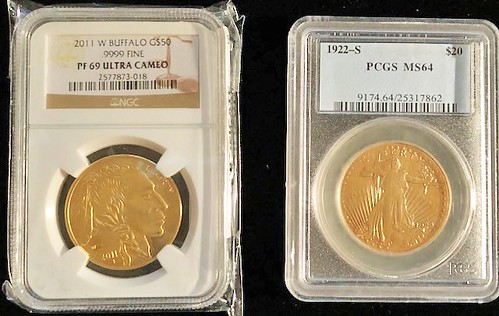
Fake coins in fake slabs
The counterfeit items are on special loan from the Cherry Hill, N.J., office of Homeland Security Investigations, U.S. Department of Homeland Security. The items were confiscated during HSI's investigation of a New Jersey man, 34-year-old Jonathan A. Kirschner, who pleaded guilty June 25 to impersonating a federal agent while selling counterfeit coins and bars and unlawfully importing counterfeit coins and bars into the United States.
The fake coins and bars in the exhibit constitute about 20 percent of the items seized during the investigation. If genuine, items in the exhibit would have a current estimated retail value of more than $10 million.
“We are highly appreciative of the Department of Homeland Security's cooperation in loaning these items for public display,” said Beth Deisher, ICTA's director of anti-counterfeiting. “It is important for collectors and the public to understand the wide range of coins and precious metals bars being counterfeited. Equally important, the buying public needs to be aware of the levels of deceptiveness. Educating the buying public is one of the best defenses we have to thwart the counterfeiters,” Deisher added.
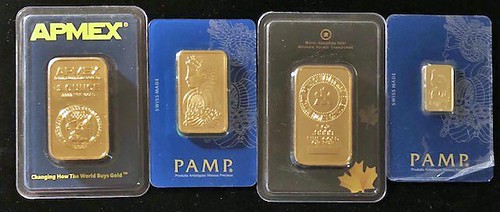
Fake gold bars
The special exhibit of counterfeits will be displayed in the non-competitive section of educational exhibits on the bourse floor of the World's Fair of Money.
“We would like to thank the ANA for its cooperation and providing the space and cases for this special exhibit,” Deisher said. “ANA's primary role is to educate the public about coins and coin collecting. Exhibits like this are an excellent method of disseminating important information,” Deisher said.
ACTF was first to alert law enforcement about Kirschner posing as an ATF agent and selling counterfeit coins. Two people took their newly purchased Morgan dollars to a coin dealer for evaluation, only to be told they were fake. The dealer alerted ACTF, which contacted federal law enforcement. Members of ACTF also worked closely with investigating agents, providing expert identification and evaluations of the counterfeit coins and bars Kirschner imported from China and other countries.
The charge of impersonating a federal officer carries a maximum potential penalty of three years in prison and the charge of unlawful importation carries a maximum potential penalty of 15 years in prison. Kirschner's sentencing is scheduled for Oct. 1.
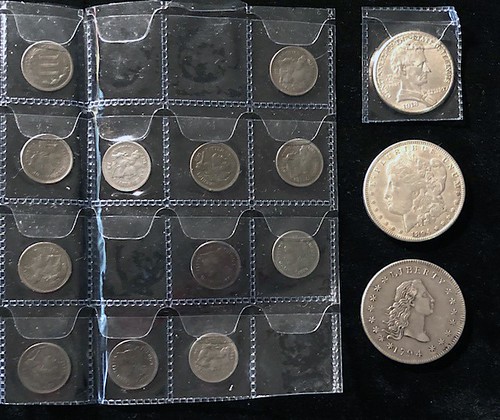
Fale nickel and silver coins
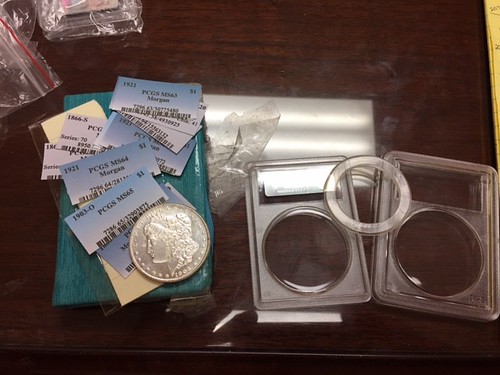
Fake Morgan dollars with fake PCGS inserts and components
Collectors and dealers alike should view this exhibit to familiarize themselves with these deceptive fakes. -Editor
For more information about the Industry Council for Tangible Assets Anti-Counterfeiting Task Force, see:
https://www.ictaonline.org/actf
A COIN UNITES VICTORIA & ABDUL
Max Hensley writes:
My wife and I just watched the Victoria & Abdul movie on HBO. If you haven’t seen it, do. Superb.
The pivotal moment is the presentation of a specimen British Indian Mohur to Queen Victoria by the protagonist Abdul for her 1887 jubilee. Accurate depiction of coin too. No regular 1887 for these though, perhaps there's one minted for the ceremony, now in the Royal collections somewhere. Coins central to movies are very rare!
Here's an excerpt from a review in The Atlantic. -Editor
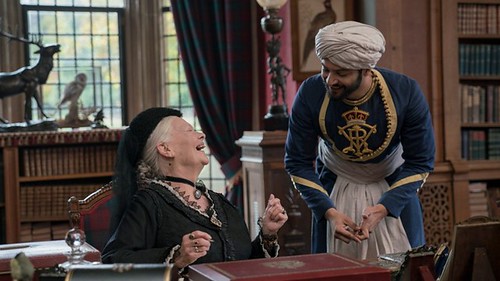
The story begins in 1887, with the Queen's Golden Jubilee, the 50th anniversary of her ascension to the throne. In her honor, a ceremonial coin is minted in India, which has been under formal British rule for nearly three decades. Two Indian clerks are chosen to present the coin by virtue of their height: Karim (played by Ali Fazal), who is in fact tall, and Mohammed (Adeel Akhtar), who is not, and was instead a last-minute fill-in.
Arriving in England, the two are instructed in the niceties of the Court (“The key to good service is standing still and moving backwards”), and solid comic mileage is gotten out of the elaborate etiquette and pantomime of a state dinner. Karim is entranced; Mohammed, not so much. (“The place is completely barbaric,” he complains, citing—in a clever inversion—the English consumption of food featuring pig's blood and sheep's brains.)
Despite instructions that he make no eye contact with the queen, Karim does exactly that at the first opportunity. She returns his gaze and, later, noting his height and looks, decides to bring him gradually into her service. She asks him to teach her Urdu and to describe the taste of a mango. Soon she has declared him her “Munshi,” or teacher, awarded him Mohammed as a servant, and had his burqa-wearing wife and mother-in-law brought to England.
To read the complete article, see:
The Lightweight Appeal of Victoria & Abdul
(https://www.theatlantic.com/entertainment/archive/2017/09/victoria-abdul-review/541491/)
Here's what the History vs Hollywood site has to say. -Editor
Did Abdul Karim come to England to present the Queen a ceremonial coin?
Not exactly, or at least not entirely. Prior to arriving in England, Abdul Karim had worked as a prison clerk in Uttar Pradesh, India, which had been under formal British rule for close to three decades. According to the Victoria and Abdul true story, the jail's superintendent, John Tyler, had met the Queen at the Colonial and Indian Exhibition of 1886, where he showcased carpets the inmates had made as part of a rehabilitation program. The Queen was impressed and asked Tyler to select two Indian attendants to help her at her Golden Jubilee, which marked fifty years of being on the throne. She wanted help communicating with the Indian dignitaries in attendance. In part due to his tallness, Abdul Karim, then 24, was chosen. In the movie, he first presents a newly minted ceremonial coin to the 81-year-old Queen. -Smithsonian Magazine
To read the earlier E-Sylum article, see:
VICTORIA AND ABDUL (2017) (http://www.historyvshollywood.com/reelfaces/victoria-and-abdul/)
Can anyone confirm the numismatic details of the coin and its whereabouts today? -Editor
NUMISMATIC NUGGETS: AUGUST 5, 2018
Here's a selection of interesting or unusual items I came across in the marketplace this week. Tell us what you think of some of these. -Editor
1825 Charleston Servant Slave Hire Tag
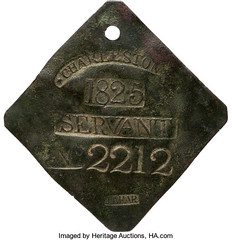
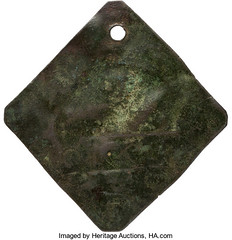
1825 Charleston SERVANT Slave Hire Tag Number 2212. Diamond-shape tag with a hole at top for suspension, clipped corners, 68 mm across. The punched inscription reads: "Charleston/ 1825/ Servant/ No 2212/ Lafar". J. J. Lafar was the Sheriff of Charleston who supplemented his income by producing slave tags for a number of years. Slightly wavy surface, but a choice example overall with very pleasing dark green patina.
From the upcoming August 25-26 Heritage Americana & Political sale. Fascinating relic of the slave era. -Editor
To read the complete lot description, see:
1825 Charleston SERVANT Slave Hire Tag Number
2212.... (https://historical.ha.com/itm/miscellaneous/ephemera/1825-charleston-servant-slave-hire-tag-number-2212/a/6183-43281.s)
c1870 Bedford County School Silver Prize Medal
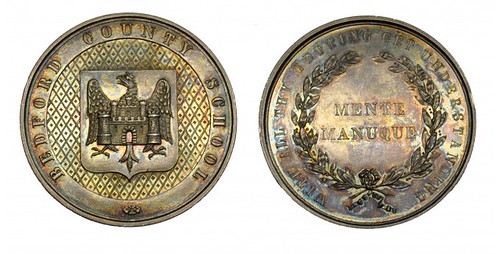
UK, Bedford County School, AR prize medal c.1870, 48mm. 59g. arms – castle over spread eagle, rev : MENTE MANQUE in laurel wreath, WITH ALL THY GETTING GET UNDERSTANDING around.
I saw this in the online stock of Baldwin's in London. Unusual cross-hatch pattern in the obverse field. Great toning, too. -Editor
To read the complete item description, see:
UK, Bedford County School, Silver Prize Medal C.1870
(https://www.baldwin.co.uk/coins/latest-items/uk-bedford-county-school-silver-prize-medal-c-1870.html?usrc=1)
1911 Exposicion Industrial del Centenario Medal
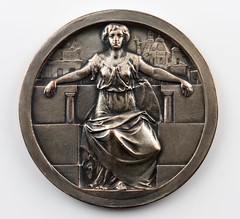
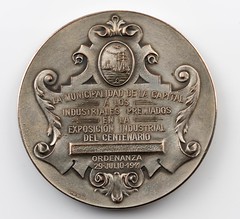
LA MUNICIPALIDAD DE LA CAPITAL A LOS INDUTRIALES PREMADOS....
Great relief. From a lot of five medals and tokens in the August 12, 2018 sale by Gibson's Auctions in Australia. -Editor
To read the complete lot description, see:
Lot 363: Five medals EXPOSICION IBERO AMERICANA, Sevilla, 1929, a bronze medallion by Arnillas Y Matallana (5.9cm)
INDUSTRIAL EXHIBITION ASSOCIATION OF TORONTO, 1879... (https://www.invaluable.com/auction-lot/-1-c-8AE474C8C9)
1929 Exposition Ibero America medal

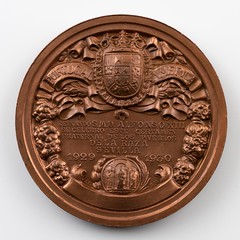
EXPOSICION IBERO AMERICANA, Sevilla, 1929, a bronze medallion by Arnillas Y Matallana (5.9cm)
Another great high-relief piece from the August 12, 2018 sale by Gibson's Auctions in Australia. -Editor
To read the complete lot description, see:
Lot 363: Five medals EXPOSICION IBERO AMERICANA, Sevilla, 1929, a bronze medallion by Arnillas Y Matallana (5.9cm)
INDUSTRIAL EXHIBITION ASSOCIATION OF TORONTO, 1879... (https://www.invaluable.com/auction-lot/-1-c-8AE474C8C9)
MEDAL SELECTIONS FROM NUMISMAGRAM: GERMANY
Jeremy Bostwick of Numismagram sent along these two medals from his recent August upload of new material. Thanks! -Editor
Jeremy adds:
The two are great examples of the mix of items routinely offered---attractive, higher grade pieces, with a particular focus on artistic and/or historical backgrounds.
The first is a rather massive medal commemorating the birth of German unifier Otto von Bismarck, featuring the popular 'wildman' motif on the reverse, while the second is an aviation type, honoring the men behind the Zeppelin company and displaying a tremendous array of toning, especially on the obverse. Also in this upload are a few attractive religious medals, a couple slabbed gems, and a handful of other highly artistic pieces. Visit numismagram.com/inventory to view all of them.
1915 Otto von Bismarck Medal

100376 | GERMANY. Otto von Bismarck cast bronze Medal. Dated 1915. Commemorating the 100th Anniversary of the Birth of Bismarck (110mm, 12h). By P. Sturm at the Grünthal Workshop in Berlin.
BISMARCK, bare head right within octagonal outline / DEM SCHÖPFER DES DEUTSCHEN REICHES (the creator of the German Empire), half-length figure of the Titan Atlas left, supporting outline of Germany (inscribed DEUTSCHLAND) on his shoulders; wreath of oak leaves around his midsection. Edge: Plain.
Cf. Gorny & Mosch Stuttgart 1, lot 1008 (which realized a hammer of €375). Choice Mint State. Essentially as issued, with a darker brown nature to its somewhat matte surfaces; a powerful and majestic piece.
A highly segmented area, the region that now comprises Germany was once broken into numerous fiefdoms under the Holy Roman Empire. As other neighboring lands in Western Europe began to coalesce their power and structure, Bismarck used his diplomacy and political skill to achieve something similar at home, forming the German Empire in 1871. From this time forward, he would be recognized and celebrated for his vital role in German unification and stature within Europe
To read the complete item description, see:
https://www.numismagram.com/product-page/100376
1928 Graf Zeppelin Medal
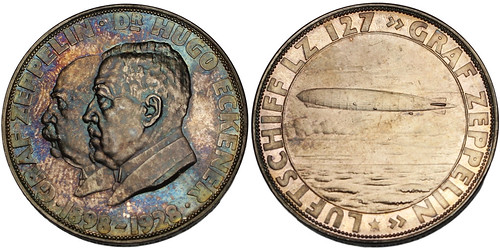
100375 | GERMANY. Ferdinand Adolf Heinrich August Graf von Zeppelin and Hugo Eckener silver Medal. Dated 1928. Commemorating the Airship LZ 127 Graf Zeppelin (36mm, 24.93 g, 12h). By J. Bernhart in München.
GRAF ZEPPELIN • DR HUGO ECKENER / 1898–1928, jugate busts of Zeppelin and Eckener left / LUFTSCHIFF LZ 127 "GRAF ZEPPELIN", airship left over the ocean. Edge: PREUSS. STAATSMÜNZE • SILBER 900 FEIN.
Hans Kaiser Coll. 493. Gem Mint State. Breathtakingly flawless surfaces, with a radiant luster and rainbow tone throughout the obverse, while a light golden brilliance highlights the reverse. An exceptionally gorgeous aviation type.
Zeppelin was a German general and aircraft manufacturer, who later founded the airship company Luftschiffbau Zeppelin. Following Zeppelin's death in 1917, Dr. Hugo Eckener became the head of this company and oversaw post-war fundraising to expand upon its production, even serving as commander for the LZ 127 on numerous occasions. When this airship first entered use, it was the first commercial passenger transatlantic flight service in the world, eventually making 590 flights over nearly a decade. In 1940, she was scrapped for metal for the German efforts in World War II.
To read the complete item description, see:
https://www.numismagram.com/product-page/100375
ESTE NUMISMATIC COLLECTION UPDATE
Hadrien Rambach forwarded this information about two new developments in the ongoing project to reconstruct the Este collection in Florence, Italy. Thank you. -Editor
Celio Calcagnini's manuscript
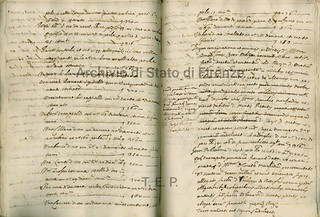
By courtesy of the Ministry of Cultural Heritage and Activities and Tourism, this site has obtained permission to publish Celio Calcagnini's entire manuscript regarding the gold coins present in the Este collection at the time when Ercole II d’Este (1534-1559) was Duke of Ferrara. The manuscript was drawn up by Celio Calcagnini between 1538 and 1541 and copied by his assistant and executor of his will, Gian Girolamo Monferrato, between 1541 and 1543. This Elenchus is limited to just gold coins, for a total of over 760 pieces, but it was to represent the first volume in the catalogue of Ercole's entire numismatic collection. The work was never finished, due to Calcagnini's death. The manuscript is conserved today at the Este University Library in Modena (Ms. Lat. 152= alfa. T6.16).
Este Gallery in Modena
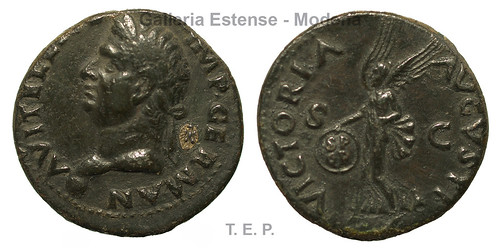
Following the collections of Este countermarked coins at the Archaeological Museum of Florence and at the Sforza Castle in Milan, next up is the Este Gallery in Modena. Photographic documentation of the collection has been successfully completed and the data regarding its roughly 300 coins is currently being entered into this site's database.
For more information on the Este project, see:
http://www.esteproject.it/
ECONOMISTS VS. ETHNOLOGISTS ON THE ORIGIN OF MONEY
Larry Lee writes:
This week's issue of Science News has two articles of the origins of money, both taken from a symposium in April sponsored by the Society for American Archeology.
The two articles are "Conflict reigns of the history and origins of money" and "How an ancient stone money system works like cryptocurrency". Make sure to read both the bibliography and the comments section as well as the articles. The articles outline two viewpoints on the origin of money: one from the economists and one from the ethnologists.
Guess there was no reason to ask the opinion of the numismatists.
Thanks. Here are excerpts from each. Interesting theories, at least. The snarky comments of academics dissing one another are amusing. -Editor
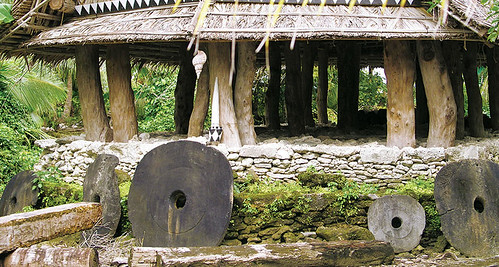
How an ancient stone money system works like cryptocurrency
At least several hundred years ago, islanders on Yap in western Micronesia used principles at the heart of cryptocurrencies to conduct business, says archaeologist Scott
Fitzpatrick of the University of Oregon in Eugene.
Ownership of a disk could be transferred, for instance, as a wedding gift, to secure political allies or in exchange for food from residents of nearby islands after a severe storm. These deals also occurred in front of the whole community. No matter who acquired a rai, it stayed in its original location.
Bitcoin and blockchain work in much the same way, Fitzpatrick says. Bitcoin “miners” solve complex mathematical puzzles to release units of currency. Those units are transported and securely stored across the public blockchain ledger. Full transaction histories for each bitcoin are available to all network participants. Bitcoins can be exchanged for goods or services or given away at any time by participants in the digital system.
To read the complete article, see:
How an ancient stone money system works like cryptocurrency
(https://www.sciencenews.org/article/yap-stone-money-bitcoin-blockchain-cryptocurrency?tgt=nr)
Conflict reigns over the history and origins of money
Economists have held one view of money's origins for hundreds of years. But a growing number of anthropologists and archaeologists, holding a revisionist view, say that
economists’ standard story is bankrupt.
Economists and revisionists alike agree that an object defined as money works in four ways: First, it serves as a means for exchanging goods and services. Currency enables payment of debts. It represents a general measure of value, making it possible to calculate prices of all sorts of items. And, finally, money can be stored as a wealth reserve.
From there, the two groups split. Mainstream economists assume that bartering of goods and services inspired money's invention. Anthropologists and archaeologists contend that early states invented currency as a means of debt payment.
To read the complete article, see:
Conflict reigns over the history and origins of money
(https://www.sciencenews.org/article/money-ancient-origins-debate-mystery?tgt=nr)
STUDY EXAMINES MEXICO'S COIN PRODUCTION COSTS
Pabitra Saha forwarded this Mexico News Daily article about the cost of producing the county's coins. Great graphic. -Editor
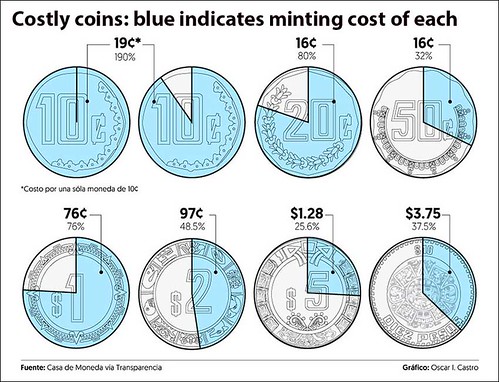
The lowest denomination of Mexican currency is the 10-centavo coin, a very small silver coin that is rarely used. But for the Bank of México (Banxico) it's a costly coin to make.
Rising costs have pushed up the price of minting a single one of the coins to 19 centavos.
That's up from nine centavos in 2012. The central bank's production costs have risen 40%, even after opting for cheaper minting processes.
To read the complete article, see:
10-centavo coins are not worth much but they’re costly little numbers
(https://mexiconewsdaily.com/news/centavos-are-costly-little-numbers/)
LUCKY EISENHOWER DOLLAR LOST AT AIRPORT
Dick Hanscom forwarded this article from the Anchorage Daily News. Thanks. Sad story. -Editor

A California firearms instructor's search for a lucky coin missing at Anchorage's airport has left him grieving the loss.
It also made him — at least briefly — internet famous.
Gary Peters carried the Eisenhower dollar in his pocket every day for 34 years — ever since his daughter gave it to him when she was 5.
Worn smooth over the years and stamped with "84" for the year he got it, the coin accompanied Peters on more than 350 skydives.
He rubbed it before greeting customers when hard times forced him to take a job at a car dealership. It went along for a deep dive off Italy in 1991, on a search for the wreckage of a reconnaissance plane that became part of World War II legend.
And now it's gone.
Peters thinks he lost the coin at Ted Stevens Anchorage International Airport on July 21.
"It feels almost like losing a family member or close friend," Peters said Thursday by phone. "I'm actually mourning. I know it sounds silly. … It's just like a piece of me."
A plea for information posted by his son-in-law on Reddit surged into viral status overnight Wednesday into Thursday.
At one point, the lost-coin post topped the popular discussion site's front page. It had been seen at least 607,000 times before an administrator took the post down.
He's offering a $500 reward, "no questions asked," to anyone who gets his beloved coin back to him.
To read the complete article, see:
Man's search for cherished coin lost
at Anchorage airport goes viral (https://www.adn.com/alaska-news/anchorage/2018/08/02/reddit-to-the-rescue-mans-search-for-coin-lost-at-anchorage-airport-goes-viral/)
SOUTH CAROLINA PALMETTO REGIMENT GOLD MEDAL
I noticed this great gold medal in Heritage's August 25-26 Americana & Political Auction. -Editor
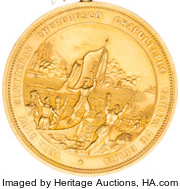
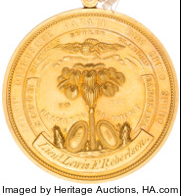
Mexican-American War: South Carolina Palmetto Regiment Gold Medal with Ribbon. Gold medal measuring 48.3 mm across, weighing 92.82 grams, awarded to 2nd Lieutenant Lewis F. Robertson. One of sixty-eight gold medals produced and awarded to veterans of the Palmetto Regiment by the grateful citizens of South Carolina in 1850 or, more likely, the senior officers (James Dickinson, Pierce Butler and Adley Gladden). This, we believe, is the eighth example known, and unrecorded. It has never been offered at auction and only recently came to light.
 The obverse has the Palmetto Tree, emblematic of South Carolina, a Latin motto which roughly
translates to "While I Breathe I Hope My Resources are in Readiness" and "Dickinson Butler Gladden To the South Carolina Palmetto Regiment" inscribed to
"Lieut. Lewis F. Robertson". The reverse features a dramatic battle scene in the center and the names of battles the regiment participated in, namely: "Vera Cruz
Contreras Churubusco Chapultepec Garita de Belen".
The obverse has the Palmetto Tree, emblematic of South Carolina, a Latin motto which roughly
translates to "While I Breathe I Hope My Resources are in Readiness" and "Dickinson Butler Gladden To the South Carolina Palmetto Regiment" inscribed to
"Lieut. Lewis F. Robertson". The reverse features a dramatic battle scene in the center and the names of battles the regiment participated in, namely: "Vera Cruz
Contreras Churubusco Chapultepec Garita de Belen".
No evidence of wear, beautifully toned with reflective surfaces, a few minute scratches of no consequence whatsoever. Original grosgrain silk ribbon with swivel suspension loop, as issued.
Little is known about Lieutenant Robertson, except that he lived in Charleston and is credited with organizing a "Charleston Company" of volunteers. The Palmetto Regiment was formally organized on June 26, 1846 and consisted of fourteen officers and seventy-two privates. Robertson served in Company F and survived the war. The troops were permitted to carry the Palmetto Flag into battle, as is depicted in sharp detail on the reverse of this medal.
Two examples were included in the John J. Ford, Jr. Collection Part VII, held on January 18, 2005 (awarded to Abner R. Dunham and N. J. Walker), graded as Choice About Uncirculated and Nice Extremely Fine. This may be the finest example extant, with the added bonus of original ribbon and suspension loop. It tests solidly as 22K, but could be 24K. A gorgeous piece!
To read the complete lot description, see:
Mexican-American
War: South Carolina Palmetto Regiment Gold Medal with Ribbon....
(https://historical.ha.com/itm/military-and-patriotic/foreign-wars/mexican-american-war-south-carolina-palmetto-regiment-gold-medal-with-ribbon/a/6183-43279.s)
MARIA DICKIN AND THE DICKIN MEDAL
Articles this week in the Weekly Standard and Philanthropy Today highlight Maria Dickin, the creator of the Dickin Medal, which honors animals who perform heroic deeds. -Editor
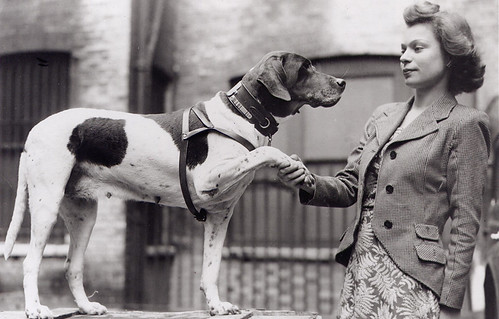
A remarkable fact of nature is that animals sometimes save our lives—and when they do they deserve credit for their achievements. Graham Hillard, an English professor at Trevecca Nazarene University, does this in his profile of the Dickin Medal in the Weekly Standard.
The Dickin Medal was the idea of Maria Dickin (1870-1951). Dickin was an energetic Edwardian social reformer. In 1917 she saw many wounded animals abandoned in poverty-stricken London. Hillard quotes Dickin, in her 1950 memoir The Cry of the Animal, saying how she saw “many dogs and cats walking on three legs, dragging along a broken or injured limb; others nearly blind with mange; covered with sores; nearly all looking dejected and miserable and searching for food in the gutter.”
Dickin resolved to help these abandoned animals, and in 1917 founded the People's Dispensary for Sick Animals, which celebrated its centennial last year. But her other great idea came about in 1943, when she noticed that animals were doing their part to win World War II. Shouldn’t they be recognized for their achievements?
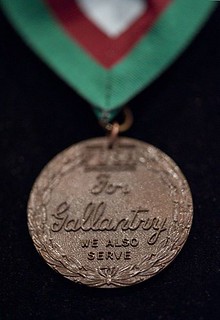 So she created the Dickin Medal, which is given
to animals who perform heroic deeds that help humans. It's the highest award an animal can get, and is regarded as the animal equivalent of the Victoria Cross.
So she created the Dickin Medal, which is given
to animals who perform heroic deeds that help humans. It's the highest award an animal can get, and is regarded as the animal equivalent of the Victoria Cross.
At first the medal was primarily awarded to pigeons. Beach Comber received a medal for conveying the first news of the abortive Canadian landing in Dieppe, France in 1942 Gustav performed a similar role with the D-Day invasion in 1944. Other pigeons provided life-saving notices of aircrews that had crashed in the desert or the sea. White Vision, the first recipient of a Dickin Medal, flew nine hours in bad weather to alert the military about a downed aircrew.
To read the complete articles, see:
Dickin Medal awards, a great philanthropic initiative
(https://www.philanthropydaily.com/dickin-medal-awards-a-great-philanthropic-initiative/)
‘We Also Serve’ (https://www.weeklystandard.com/graham-hillard/we-also-serve)
MCDONALD's ISSUES 50TH ANNIVERSARY BIG MAC COINS
Last Sunday night I apparently missed the chance to be among the first in the numismatic press to cover the breaking story of the new McDonald's Big Mac good-for tokens. John Mutch forwarded this USA Today story about 9pm my time, as I was working on finishing the week's E-Sylum issue. The supposed discovery of an unknown 1894-S dime was one of those stop-the-presses moments, but Burger tokens? No so much. I decided to press on without the Big Mac news, but I'm actually glad I waited - now we have more than just a company media blitz to go on. Here's an excerpt from that initial article, followed by some of the week's coverage in the numismatic community. Thanks, John! -Editor
It's not exactly pennies from heaven, but McDonald's is planning to make it rain coins to celebrate the Big Mac's 50th anniversary.
Starting at the lunch rush on Thursday, customers can receive a MacCoin with the purchase of a Big Mac at 14,000 participating restaurants across the United States, McDonald's announced Sunday.
And what's the coin good for? Another Big Mac.
Customers can redeem the new currency for a free Big Mac starting Friday and running throughout the rest of 2018.
In an Interview with USA TODAY, McDonald's CEO Steve Easterbrook explained Thursday was selected as the release date for the brass-colored coins because it would’ve been the 100th birthday of Jim Delligatti, a McDonald's franchisee in western Pennsylvania who invented the Big Mac.
McDonald's sold 1.3 billion Big Macs last year, according to the chain.
MacCoins will feature five unique designs, each representing a decade of the Big Mac.
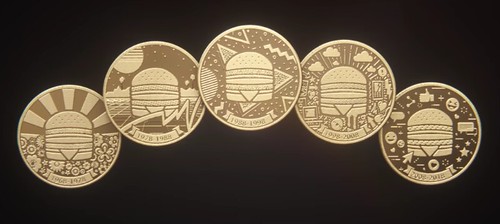
To read the complete article, see:
McDonald's unveils MacCoin to celebrate Big
Mac's 50th anniversary (https://www.usatoday.com/story/money/2018/07/29/mcdonalds-unveils-maccoin-celebrate-big-macs-50th-anniversary/844522002/)
Here's an excerpt from Coin World's take, in an article by Paul Gilkes. He notes that the tokens were struck at Cincinnati's Osborne Coinage Co., the oldest private mint in the U.S. -Editor
The sandwich that inspired the jingle “two all-beef patties, special sauce, lettuce, cheese, pickles, onions on a sesame seed bun” was invented in 1967 in the kitchen of Jim Delligatti's first McDonald's franchise, located on McKnight Road in suburban Pittsburgh's Ross Township. The sandwich was introduced at that location first, and then went nationwide in 1968.
Each MacCoin token has no cash value and is redeemable only for one free Big Mac at participating McDonald's restaurants through 2018.
The commemorative tokens feature five unique reverse designs, one representing each decade of the Big Mac.
As a Pittsburgh native it's a point of local pride that the iconic sandwich was born there, and I probably consumed a few in my teenage visits to the McKnight Road location and elsewhere with my family in later years. -Editor
To read the complete article, see:
McDonald's celebrates Big Mac 50th anniversary with token promotion
(https://www.coinworld.com/news/us-coins/2018/08/mcdonalds-launches-big-mac-token-promotion.html)
Dave Harper of Numismatic News is excited about the opportunity to promote token collecting and numismatics in general. Here's an excerpt of his August 3, 2018 article. -Editor
They were issued by McDonald's to celebrate the 50th anniversary of the Big Mac. Hooray.
You can bet I will be at my local McDonald's repeatedly to buy a Big Mac and receive my coin.
It looks like I will have to return again and again to collect the whole set. There will be five designs. Each of them honors one decade in the 50-year run of this tasty burger.
The question is, will this promotion appeal to younger generations? Will many of them discover when they receive and use these MacCoins that they have an interest in coin collecting? I hope so.
The coin collecting hobby could not ask for a greater promotional gift. There are millions of customers of the Golden Arches. This is a 50-country promotion.
The most critical aspect to this promotion is that MacCoins are intended to be used. They will be redeemable for the rest of 2018. Technically, this makes them a good-for token. They have value because they are good for a Big Mac. They are spendable only with the issuer, which is the historic purpose of a good-for token.
If I seem a little excited, I am.
Who would have thought in the age of Bitcoin that we would see a national chain of restaurants revert to something so familiar to coin collectors as a new promotion?
To read the complete article, see:
Who has hunger for the new MacCoins?
(http://www.numismaticnews.net/article/who-has-hunger-for-the-new-maccoins)
I think I agree with Dave - with video arcade tokens largely a thing of the past, this is an opportunity to introduce a new generation to the use of tokens. And in a sign of how fast the hobby moves today, Numismatic Guaranty Corporation (NGC) announced on August 2, 2018 that it was certifying the tokens. -Editor
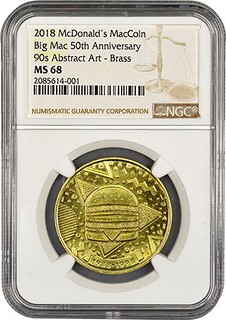
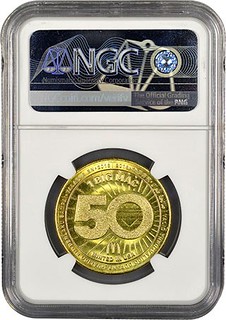
NGC, the world's largest third-party grading service for coins, medals and tokens, has already begun to receive MacCoins for certification.
NGC examined a MacCoin in its X-ray fluorescence (XRF) spectrometer, and determined it to be brass — or, more precisely, 70 percent copper and 30 percent zinc. The MacCoin has a diameter of 32 mm and weighs 10.9 grams, making it slightly wider and lighter than a Kennedy Half Dollar.
According to McDonalds, more than 6.2 million MacCoins will be distributed.
OK, so the tokens have hit the streets by the time you're reading this. Have you or any of your friends spotted one? Had one slabbed? Or making plans to cash one in on a juicy Big Mac? -Editor
John Mutch writes:
After getting Big Macs for my wife and I on Thursday just to get a couple of the pieces, I stopped by a McDonalds on Friday and was told the McCoins were all gone.
To read the complete article, see:
NGC Grading McDonald's MacCoin Tokens (https://www.ngccoin.com/news/article/6759/maccoin/)
INTERVIEW: MARK SALZBERG OF NGC
For more on where the field of collectibles certification is heading, check out John Feigenbaum's interview with NGC Chairman Mark Salzberg. -Editor
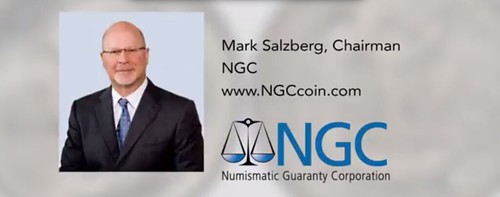
CDN Publisher John Feigenbaum recently had the pleasure of interviewing Mark Salzberg, chairman and grade finalizer at Numismatic Guaranty Corporation (NGC). Salzberg, who received the American Numismatic Association (ANA) Presidential Award in 1998 and was named the ANA Numismatist of the Year in 2006, has handled some of the world's rarest and most fascinating coins. He has also helped standardize grading across the coin industry and has published numerous articles about rare coins and the marketplace.
In this interview, Salzberg tells about the serendipitous occurrence that got him involved with collecting coins as a young boy, his early days as a dealer, and his rise as a leader at NGC. He also shares exciting details on the newest NGC subsidiary, Collectibles Authentication Guaranty (CAG), which certifies relics from famous estates, such as lunar memorabilia from the family of Neil Armstrong — the first man to walk on the Moon. How may CAG eventually help preserve museum artifacts and potentially bring more of these rare items, many long hidden away in drawers and vaults, to the public? Salzberg explains what CAG is embarking on now and his exciting vision for the future.
To watch the video, see:
CDN Exclusive: NGC's Mark Salzberg Shares His Vision for the Future of Collectibles Certification
(http://blog.greysheet.com/mark-salzberg-interview-aug2018/)
CRANE PAPER'S U.S. CURRENCY CONTRACT
A Great Escape and women's undergarments figure into the story of how Crane paper company got the exclusive contract to produce paper of U,S, currency. Thanks to the July 17, 2018 News & Notes from the Society of Paper Money collectors for a story from the Berkshire Edge. Here's an excerpt. -Editor
1879: “W. Murray Crane wins a heated competition to make US currency paper.”
There are stories about how Crane won that coveted contract. Some are true; some apocryphal. One has W. Murray Crane locked in a downtown Washington, D.C., hotel room. The government placed a deadline — date and hour — by which time all interested manufacturers must submit their proposals with paper samples. Crane traveled to D.C., but a competitor locked Crane in his room to assure he missed the deadline. Crane made the deadline and won the contract.
...by climbing out through the transom! -Editor
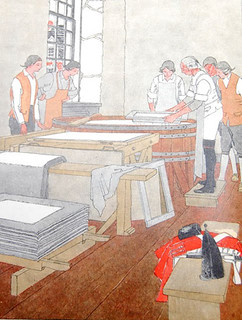 In Dalton, odds and ends of the family
wardrobe may have been looked upon as useless. In 1806 Crane wanted every scrap. Why women's underwear? Crane assumed they would be made of the finer cotton. Why Granny's nightie?
Crane assumed it would be made of linen. Zenas made cotton paper for local and regional banks. In 1844 Crane developed a method to embed parallel silk threads into the banknote
paper to dissuade counterfeiters.
In Dalton, odds and ends of the family
wardrobe may have been looked upon as useless. In 1806 Crane wanted every scrap. Why women's underwear? Crane assumed they would be made of the finer cotton. Why Granny's nightie?
Crane assumed it would be made of linen. Zenas made cotton paper for local and regional banks. In 1844 Crane developed a method to embed parallel silk threads into the banknote
paper to dissuade counterfeiters.
By the time Murray Crane got to that hotel room in D.C., Crane Paper had a product that was a special blend of cotton and linen and gave the paper a unique “hand.” Remember the paper samples presented with the proposal? Crane paper had that distinct feel that everyone, from that day to this, associates with American money. Most probably that won the contract. It gives “rags to riches” a whole new meaning.
In 1879 Crane Paper Company secured its most illustrious customer — the United States government.
To read the complete article, see:
CONNECTIONS: How ladies undergarments
secured Crane Paper the U.S. currency contract
(https://theberkshireedge.com/connections-the-history-of-u-s-currency-paper-involves-an-escape-plan-and-womens-undergarments/)
THE HISTORY OF ‘IN GOD WE TRUST’
On July 30, 2018 Politico magazine published a piece about the “In God We Trust” motto. -Editor
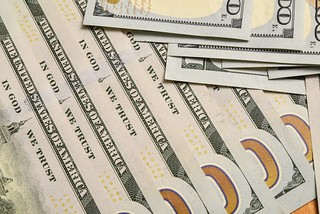 On this day in 1956, President Dwight
D. Eisenhower signed into law a bill declaring “In God We Trust” to become the nation's official motto. Under the legislation, Congress further mandated that the phrase be printed
(in capital letters) on every domination of U.S. paper currency.
On this day in 1956, President Dwight
D. Eisenhower signed into law a bill declaring “In God We Trust” to become the nation's official motto. Under the legislation, Congress further mandated that the phrase be printed
(in capital letters) on every domination of U.S. paper currency.
It serves as a replacement and, in some cases, an alternative, to an earlier unofficial Latin motto of E pluribus unum (“Out of Many One”), which was adopted when the Second Confederation Congress created the Great Seal of the United States in 1782.
The motto first appeared on U.S. coins in 1864, during the Civil War, when religious sentiment reached a peak, according to the historical association of the U.S. Treasury.
In 1908, Congress had mandated that the phrase be printed on all coins upon which it had previously appeared. This decision was motivated after a public outcry following the release of a $20 coin which did not bear the motto. It has been in continuous use on 1-cent coin since 1909, and on the 10-cent coin since 1916. It also has appeared on all gold coins and silver dollar coins, half-dollar coins and quarter-dollar coins struck since July 1, 1908. It disappeared from 5-cent coins in 1883 and did not appear again until production of the Jefferson nickel began in 1938. Since then, all U.S. coins have borne the motto.
The first paper currency bearing the motto entered circulation Oct. 1, 1957, when it appeared on the $1 silver certificate. Gradually, as new indigo printing processes were perfected, the motto was printed on all currency denominations. The initial idea of adding the motto to paper currency came from George Humphrey, Eisenhower's treasury secretary.
To read the complete article, see:
‘In God We Trust’ becomes nation's motto, July 30, 1956
(https://www.politico.com/story/2018/07/30/in-god-we-trust-becomes-nations-motto-july-30-1956-741016)
The Conversation published an article by on February 8 that has some nice images and a little more history. -Editor
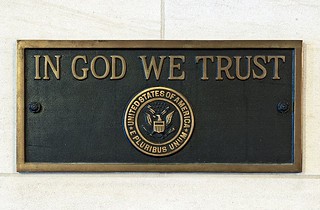
The U.S. Capitol's 'In God We Trust' plaque
To read the complete article, see:
The complex history of ‘In God We Trust’
(https://theconversation.com/the-complex-history-of-in-god-we-trust-91117)
APP BRINGS NELSON MANDELA BANKNOTES TO LIFE
Some banknote issuers have created smartphone apps to educate their users. Among the latest is the South African Reserve Bank, whose app brings their new Mandela notes to life. -Editor
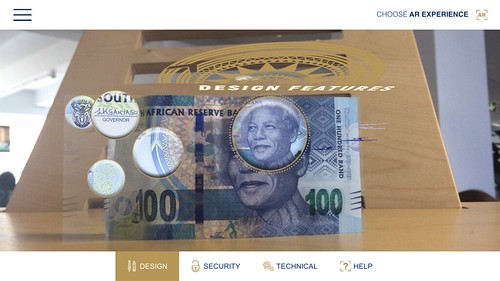
The new ‘Madiba’ banknotes from the South African Reserve Bank come to life through an augmented reality app – an exciting new feature not yet seen on South African currency.
Called the SARB Currency app, you can download it from the Google Play or Apple iStore for free.
Scanning in your note allows you to experience the late president's story as it jumps off the paper.
Images become three-dimensional and a whole new world opens up on the notes. Detailed Eastern Cape and Robben Island dioramas almost took our breath away.
“We worked a lot on the stories from Madiba's life that inspired the themes and designs for the app,” said Sea Monster CEO Glenn Gillis, whose company built the app.
"One of the biggest challenges was the fact that money - the actual notes - aren't always flat and clean which is ideal for AR. Bank notes are handled by many people, they get shoved in pockets or into the bottom of bags, so that by the time they're used they can often be a crumpled mess. We wanted to create an app that would still work within those parameters and didn't just require a pristine banknote," said Gillis.
The app won’t verify a bank note, but it is aimed at educating users about identifying counterfeit notes. The SA Reserve Bank launched the new notes in honour of Nelson Mandela, who would have turned 100 years this year.
To read the complete article, see:
There's a secret game inside your new bank notes -
here's how to play (https://www.businessinsider.co.za/theres-a-secret-game-inside-your-new-madiba-bank-notes-heres-how-to-play-2018-7)
MEN SENTENCED FOR STEALING SANTA MARGARITA BAR
The men who stole a gold bar from the Mel Fisher treasure museum have been sentenced. -Editor

The two men responsible for stealing a gold bar from a Key West treasure museum were sentenced Monday at the federal courthouse in Key West.
The two drove to Key West from Palm Beach County in August of 2010. Security video from the Mel Fisher Maritime Museum shows them both hanging around the museum near closing time and returning repeatedly to the museum's most popular exhibit — a gold bar in a clear case with a hole in front. Museum visitors were encouraged to reach in to touch and lift the gold bar, which came from the Santa Margarita, a Spanish treasure galleon that wrecked off the Keys in 1622.
The "lift-a-gold-bar" exhibit was the museum's centerpiece, and featured heavily in their marketing.
"Probably about 3 to 4 million people lifted that bar," Kendrick said. "Even if you have the insurance money for it, you can't replace it. There's not another."
To read the complete article, see:
Gold Bar Thieves Sentenced, Ordered To Pay Half Million In
Restitution To Keys Museum (http://www.wlrn.org/post/gold-bar-thieves-sentenced-ordered-pay-half-million-restitution-keys-museum)
Dick Hanscom sent this story from the Daily Mail. Thanks. -Editor
The two men who swiped a 17th century gold bar from a maritime museum in Florida will face time behind bars for stealing, chopping up and selling the 'priceless' artifact.
Richard Steven Johnson, 41, and Jarred Alexander Goldman, 32, led their heist on August 18, 2010 where they broke into a display case at the Mel Fisher Maritime Museum and took the $560,000 oblong bar from its perch.
The pair were handed prison sentences on Monday after they said they destroyed the artifact by cutting it up and selling it in Las Vegas.
The relic had been aboard the Santa Margarita, a Spanish galleon that sank in the Florida Straits in 1622 with more than 9,000 ounces of gold plundered from the Americas. The stolen bar has not been located.
Treasure hunter Mel Fisher, for whom the museum is named, discovered part of the Santa Margarita wreck in 1980 while scouring the sea floor for ships which were once in a fleet sailing treasures back to Spain.
To read the complete article, see:
Two thieves are jailed for stealing, chopping up and
selling 'priceless' 17th century gold bar swiped from a Key West museum in 2010
(http://www.dailymail.co.uk/news/article-6009283/Two-thieves-jailed-stealing-priceless-17th-century-gold-bar.html)
IN OTHER NEWS: AUGUST 5, 2018
Here are some additional items I came across in the media this week that may be of interest. -Editor
Detectorist Discovers Roman Gold Signet Ring
Katie de Silva forwarded this BBC News video, noting "The stuff that dreams are made of. The hoard of 30 coins wasn't even mentioned in the video." -Editor
 An amateur metal detectorist has
discovered a Roman gold signet ring in a Somerset field.
An amateur metal detectorist has
discovered a Roman gold signet ring in a Somerset field.
The 48g ring was uncovered at the same site, in Crewkerne, where a rare Roman lead-lined coffin was found.
It's thought to be 24-carat gold with an onyx engraving of the God of Victory.
The ring is yet to be fully assessed by the British Museum but local finds officers believe it dates from 200-300 AD.
To read the complete article, see:
A metal detectorist discovered the Roman gold signet
ring (https://www.bbc.com/news/av/uk-england-somerset-45038710/a-metal-detectorist-discovered-the-roman-gold-signet-ring)
Update: Carnegie Library Theft
Here's an update on the case against the librarian and book store owner accused of stealing $8 Million worth of rare books from the Carnegie Library of Pittsburgh. Nothing really new, just a procedural hearing. -Editor
An Allegheny County prosecutor on Thursday argued to a judge that Caliban Book Shop in Oakland ought to be shut down so that its owner, charged with participating in a conspiracy to steal hundreds of rare books, maps and plates from the Carnegie Library of Pittsburgh and then selling them through his store and warehouse, cannot profit from his crime.
The judge Thursday found the prosecution's request too burdensome and instead said the shop can continue to operate.
Judge Manning ruled that Mr. Schulman can have access to the accounts to ensure that his employees and the store's utilities and rent are paid. Neither Mr. Schulman nor his wife, co-owner Emily Hetzel, however, can receive money from them, Judge Manning said.
To read the complete article, see:
Judge forbids
profits but lets Caliban Book Shop owner, charged in Carnegie Library theft, pay store's bills
(http://www.post-gazette.com/news/crime-courts/2018/08/02/Caliban-Book-Shop-Carnegie-Library-Pittsburgh-theft-rare-books-john-schulman/stories/201808020158)
George Kolbe writes:
It was fun, years ago, when we visited the Carnegie and viewed many of their rare numismatic works. Now, It gives me the creeps when I recall rare plated Tom Elder sale catalogues sitting in a pile on a bookshelf with other more ubiquitous coin sale catalogues; essentially, they were hiding in plain sight. Chances are that their value was not perceived. Still… And then there were many other items with substantial monetary value far more easily discerned.
George included a link to an article on the theft in a Rare Book Monthly. Thanks. -Editor
To read the complete article, see:
Arrests Made in $8 Million Theft from Pittsburgh's Carnegie Library (http://www.rarebookhub.com/articles/2464)
To read the earlier E-Sylum articles, see:
CARNEGIE LIBRARY OF PITTSBURGH RARE BOOK THEFTS (http://www.coinbooks.org/v21/esylum_v21n12a07.html)
CARNEGIE LIBRARY RARE BOOK THEFT DEVELOPMENTS (http://www.coinbooks.org/v21/esylum_v21n26a24.html)
CARNEGIE RARE BOOK THEFT HEARING SCHEDULED (http://www.coinbooks.org/v21/esylum_v21n29a26.html)
Graham Short Releases Another Micro-Engraved Banknote
Micro-engraver Graham Short is at it again - he spent one of his artworks, which could be worth a nice sum to the finder. Thanks to Arthur Shippee for forwarding this one. -Editor
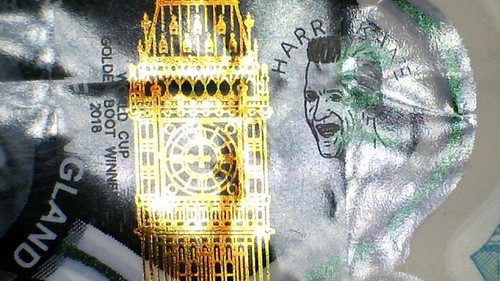
A £5 note engraved with the image of England striker Harry Kane has gone into circulation in Merthyr Tydfil.
Micro-engraver Graham Short made six of the notes after Kane won the Golden Boot for scoring the most goals during the 2018 World Cup.
He used the note at a shop in Cefn Coed last Wednesday.
The artist previously etched Jane Austen on to new £5 notes when they were first circulated and those have been valued at £50,000.
Mr Short, from Birmingham, chose Merthyr Tydfil because his father was born in nearby Dowlais.
To read the complete article, see:
Harry Kane '£50,000' fiver spent in Merthyr Tydfil off licence
(https://www.bbc.co.uk/news/uk-wales-south-east-wales-45038306)
FEATURED WEB SITE: FICTIONAL CURRENCY
This week's Featured Web Site is the fictional currency section of the deviant Art web site.This group is a showcase of the fictional currencies which our fellow deviants have made, be it for a fictional world, a video game, concept art for actual currency, or whatever!
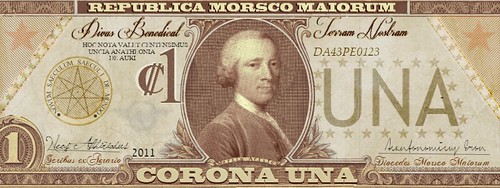
https://www.deviantart.com/fictional-currency/


